文章
Eyin Thor
2017年05月23日

Learn how to grow poppies in this article. Even if you don’t have a space for large flower beds, by growing poppies in pots you can still enjoy the colorful blooms of this stately flowering plant.

Beautiful and seemingly delicate, the poppies are the plants not particularly very easy to grow but the beauty of the flowering plant makes it a popular classic. Those who want to enjoy the intense blooms in their container gardens must grow poppies in pots.
Best Poppy Varieties
There are some of the varieties of poppies that are popular and can grow well in a pot:
Oriental poppy
Most of the oriental poppy cultivars have large strikingly beautiful flowers that usually appears in late spring to early summer in bright colors like orange and red. There are also softer colors of this perennial flowering plant: pink, white and purple, with or without a central spot.
Height: 0.40 to 1.20 m.
USDA Hardiness Zones: 2-9
Iceland poppy
Usually grown as an annual or biennial.This short living perennial is self-seeding and come year after year, does not like the hot summers. Lightly perfumed flowers appear from mid spring to mid summer in colors like yellow, orange, red, pink and white. Flowers of this cultivar fade slowly than other poppies.
Height: 0.30 to 0.6 m.
USDA Hardiness zones: 3-9
California poppy
The showy state flower of California is a short-lived perennial in warm temperate and subtropical climates (USDA Zone 8-10). If you want to grow poppy in a tropical climate, try California poppy, keeping the plant in partial shade in summer.
Height: 0.15 to 0.45 m.
USDA Zones: 6-10b
Shirley poppy
One of the most beautiful and delicate poppies. Shirley Poppy is the name given to an ornamental cultivar group derived from the European wild field poppy (Papaver rhoeas).
Height: up to 0.6 m
USDA Zones: 3-9, can be grown in zones 10 & 11 as annual but doesn’t tolerate tropical heat well.
Choosing a Pot
Growing poppies in pots is easy, the plant is best grown in a medium sized pot. As poppies don’t tolerate waterlogged soil, ensure the pot has sufficient drainage holes in the bottom so that the water will drain freely.
How to Grow PoppiesSowing Seeds and Planting
1. Poppy grows well from seeds. Make sure that you place the pot in a bright position after planting seeds as poppy seeds require light to germinate. Also, most of the poppies do not like being transplanted, so either choose a pot that biodegradable or plant seeds in the exact pot in which you wish to grow poppy plants later.
2. Disperse seeds by hand in the pot. As the poppy seeds are very small, gardeners often mix them with sand to achieve a more equitable distribution. This also helps to see where the seeds were sown.
3. Tamp the seeds lightly down on the soil so that they are covered by a very thin layer of soil or sand. This keeps the seeds in place and they’ll also get plenty of light for germination. Once the seeds are planted moisten the soil making sure you don’t move the seeds.
4. Keep the soil constantly moist until germination. Germination depends on the climate and species but usually occurs within 25 days.
5. Poppies have a very delicate root system in the beginning so once the seedlings sprout water them gently. Thin out the seedlings 4-6 inches apart, when they reach a height of 5 inches. If you are planting in a medium to the large sized pot you can easily keep more than one plant per pot.
Requirements for Growing Poppies in Pots

Location
Poppies love the sun, so place your pots in a spot that receives ample sunlight, at least 6-7 hours daily. However, if you live in a warm climate where the sun is intense, grow poppies in partial sun.
Soil
Poppies can thrive on a variety of soils unless it is clay rich and blocks the drainage, the best is to use humus rich, loamy potting mix. The substrate should be neither too loose, nor prone to compaction and must be well draining. Slightly acidic to neutral soil pH is recommended.
Watering
When the poppies are in bloom or about to bloom in warm season, watering must be moderate and regular. On the contrary, once you get past the period of flowering, best to leave the soil dry as much as possible and watering must be done only when the top one inch surface of soil seems dry.
Poppy Plant Care
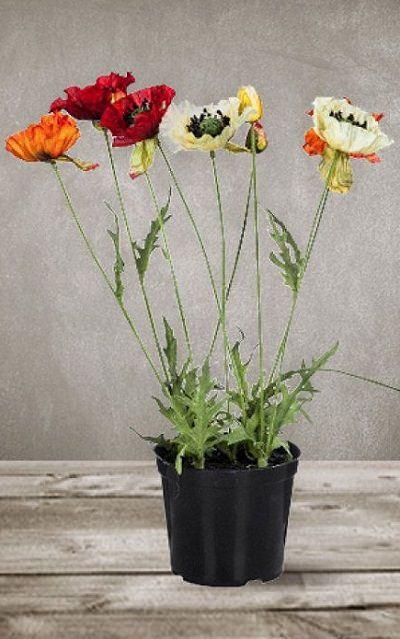
Fertilizer
Poppies are not heavy feeders; on the ground, they tolerate poor soil and thrive on their own but when growing poppies in pots you’ll need to fertilize the plant. At the time of planting or at the beginning of growing season, usually, spring (fall in warm frost-free climates), add a slow-release fertilizer to provide a steady supply of nutrition to plant during the whole season.
If you haven’t added a slow release fertilizer start to feed the plant with balanced liquid fertilizer on a bi-weekly basis once the plant has exceeded the height of 5 inches or when new growth emerges in spring. You can also feed the plant with flower fertilizer during the flowering period. Cease the application of fertilizer once the growing period ends.
Also, poppies are prone to magnesium and iron deficiency, application of Epsom salt is recommended.
Deadheading
Cut off the faded flowers to encourage more blooms.
Pests and Diseases
If the pot is not well draining or if you overwater the plant, it may die due to root rot. It also suffers from powdery mildew. In pests, keep an eye on aphids and spider mites.

Beautiful and seemingly delicate, the poppies are the plants not particularly very easy to grow but the beauty of the flowering plant makes it a popular classic. Those who want to enjoy the intense blooms in their container gardens must grow poppies in pots.
Best Poppy Varieties
There are some of the varieties of poppies that are popular and can grow well in a pot:
Oriental poppy
Most of the oriental poppy cultivars have large strikingly beautiful flowers that usually appears in late spring to early summer in bright colors like orange and red. There are also softer colors of this perennial flowering plant: pink, white and purple, with or without a central spot.
Height: 0.40 to 1.20 m.
USDA Hardiness Zones: 2-9
Iceland poppy
Usually grown as an annual or biennial.This short living perennial is self-seeding and come year after year, does not like the hot summers. Lightly perfumed flowers appear from mid spring to mid summer in colors like yellow, orange, red, pink and white. Flowers of this cultivar fade slowly than other poppies.
Height: 0.30 to 0.6 m.
USDA Hardiness zones: 3-9
California poppy
The showy state flower of California is a short-lived perennial in warm temperate and subtropical climates (USDA Zone 8-10). If you want to grow poppy in a tropical climate, try California poppy, keeping the plant in partial shade in summer.
Height: 0.15 to 0.45 m.
USDA Zones: 6-10b
Shirley poppy
One of the most beautiful and delicate poppies. Shirley Poppy is the name given to an ornamental cultivar group derived from the European wild field poppy (Papaver rhoeas).
Height: up to 0.6 m
USDA Zones: 3-9, can be grown in zones 10 & 11 as annual but doesn’t tolerate tropical heat well.
Choosing a Pot
Growing poppies in pots is easy, the plant is best grown in a medium sized pot. As poppies don’t tolerate waterlogged soil, ensure the pot has sufficient drainage holes in the bottom so that the water will drain freely.
How to Grow PoppiesSowing Seeds and Planting
1. Poppy grows well from seeds. Make sure that you place the pot in a bright position after planting seeds as poppy seeds require light to germinate. Also, most of the poppies do not like being transplanted, so either choose a pot that biodegradable or plant seeds in the exact pot in which you wish to grow poppy plants later.
2. Disperse seeds by hand in the pot. As the poppy seeds are very small, gardeners often mix them with sand to achieve a more equitable distribution. This also helps to see where the seeds were sown.
3. Tamp the seeds lightly down on the soil so that they are covered by a very thin layer of soil or sand. This keeps the seeds in place and they’ll also get plenty of light for germination. Once the seeds are planted moisten the soil making sure you don’t move the seeds.
4. Keep the soil constantly moist until germination. Germination depends on the climate and species but usually occurs within 25 days.
5. Poppies have a very delicate root system in the beginning so once the seedlings sprout water them gently. Thin out the seedlings 4-6 inches apart, when they reach a height of 5 inches. If you are planting in a medium to the large sized pot you can easily keep more than one plant per pot.
Requirements for Growing Poppies in Pots

Location
Poppies love the sun, so place your pots in a spot that receives ample sunlight, at least 6-7 hours daily. However, if you live in a warm climate where the sun is intense, grow poppies in partial sun.
Soil
Poppies can thrive on a variety of soils unless it is clay rich and blocks the drainage, the best is to use humus rich, loamy potting mix. The substrate should be neither too loose, nor prone to compaction and must be well draining. Slightly acidic to neutral soil pH is recommended.
Watering
When the poppies are in bloom or about to bloom in warm season, watering must be moderate and regular. On the contrary, once you get past the period of flowering, best to leave the soil dry as much as possible and watering must be done only when the top one inch surface of soil seems dry.
Poppy Plant Care

Fertilizer
Poppies are not heavy feeders; on the ground, they tolerate poor soil and thrive on their own but when growing poppies in pots you’ll need to fertilize the plant. At the time of planting or at the beginning of growing season, usually, spring (fall in warm frost-free climates), add a slow-release fertilizer to provide a steady supply of nutrition to plant during the whole season.
If you haven’t added a slow release fertilizer start to feed the plant with balanced liquid fertilizer on a bi-weekly basis once the plant has exceeded the height of 5 inches or when new growth emerges in spring. You can also feed the plant with flower fertilizer during the flowering period. Cease the application of fertilizer once the growing period ends.
Also, poppies are prone to magnesium and iron deficiency, application of Epsom salt is recommended.
Deadheading
Cut off the faded flowers to encourage more blooms.
Pests and Diseases
If the pot is not well draining or if you overwater the plant, it may die due to root rot. It also suffers from powdery mildew. In pests, keep an eye on aphids and spider mites.
4
1
文章
Gina
2017年05月23日

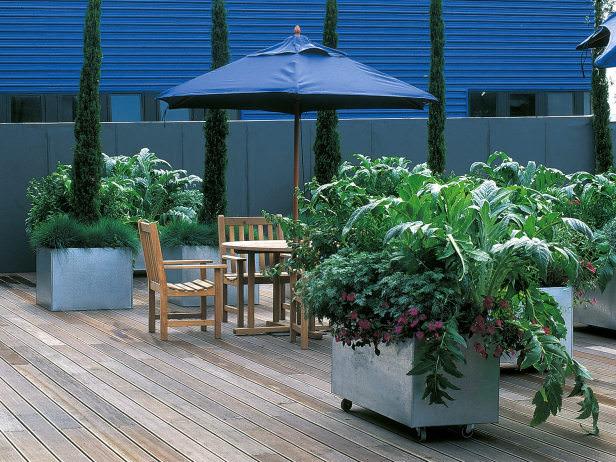
A lot of us love our container gardens… They allow you to grow things in a small space, or in a “no garden” space like a balcony, they cut down on maintenance chores, and they bring plants right up to the places you spend time so you can enjoy them! Oh, and they are pretty, too! But did you know you can go beyond the traditional annuals in a container? Almost anything can be grown in a container when the right requirements are met, don’t be afraid to think out of the box. (Or pot!) First, a quick refresh on the basics for container gardening.
Always match the size of the container to the size of the plants, especially large plants. Nothing makes a container garden fail faster than outgrowing it’s space too quickly!
That having been said, plants in container should be placed closer together than they would be in the ground. Everything is concentrated into a smaller space, including water and fertilizer, so they can tolerate, and look better, planted snugly. This especially applies to annuals that have shallow root systems and only last one season.
Always choose a good potting mix for your container, never use garden soil. Garden soil placed into containers is not light enough and will compact, not allowing the roots to breathe.
Containers need lots of water. In the heat of summer, especially smaller containers may need watering every day. You can set up a drip system if you group your containers together. Also, watch for pots that dry out extremely fast… Dark colored pots, metal pots or porous pots like terra cotta can be zapped of water in a few hours in the hot summer sun.
Fertilizer also leaches out of the container faster. Use a diluted liquid fertilizer every two weeks for most container grown plants. Consider using a potting mix with fertilizer pre-mixed in, like Miracle Gro.
One of the benefits of using containers is that they are mobile. Remember to outfit larger containers with wheeled platforms to make moving them easier, or use a hand truck.
Here are our picks for best unexpected plants you can grow in containers.
Our first picks are from ‘HGTV Gardens‘, both above and below. The top photo is a great example of using containers with unexpected plants. The focal plant (the taller spiky one) in these mobile containers are artichokes! Filled in with perennials and annuals, these containers offer a great aesthetic, and veggies too. Below is an example of using containers to create a typical hedge. Instead of plantings these boxwood straight in the ground, they are higher up to block views, and can be moved if necessary. Yep, they look cool too.
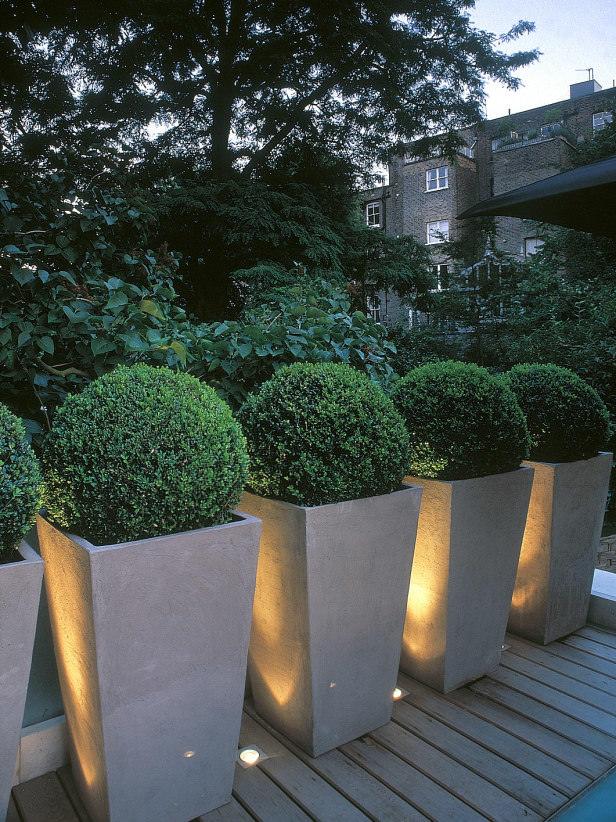
Don’t think you can plant trees in containers? Think again. These birch trees are placed in large containers, and because the root ball is kept from growing outward, the whole tree remains smaller and more manageable. Oh, yes, did we mention you can move them? Photo by ‘My Landscapes‘.
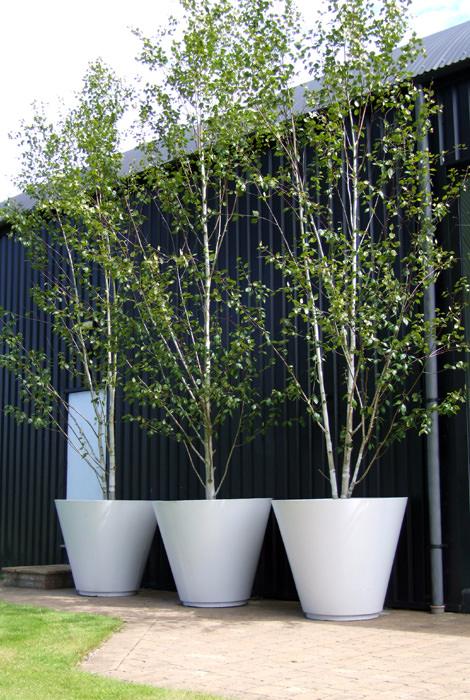
Want trees that give a little bit more? ‘A Cultivated Nest’ shows us how to grow apple trees in containers. She uses them as screens, and the apples are a bonus! There are lots of other type of fruit trees that come in dwarf or columnar varieties as well. Check out her tip on self pollinating varieties.
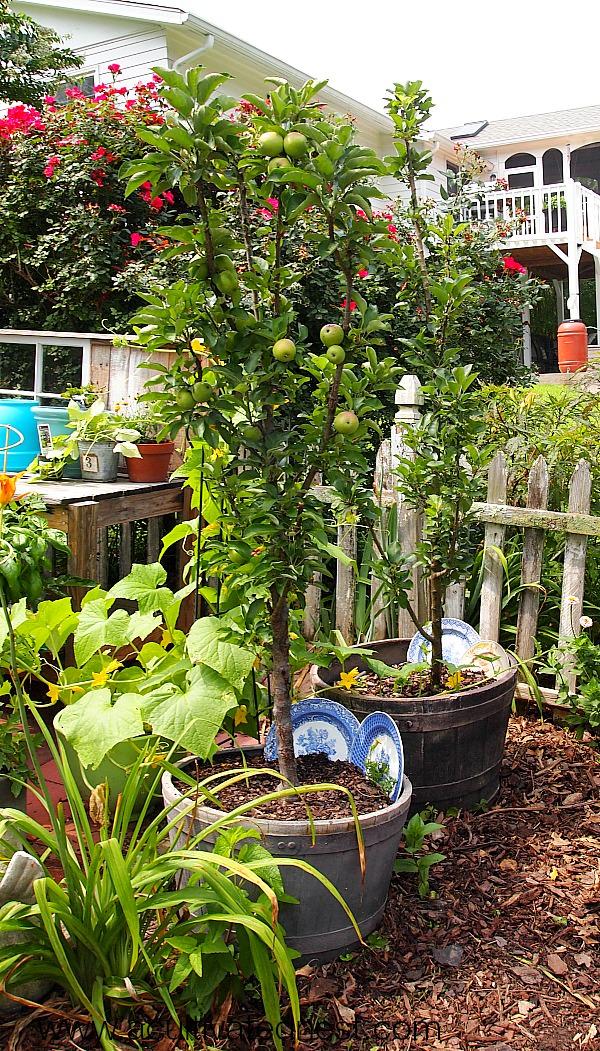
Citrus trees can be tough to grow in some parts of the country. Did you know that if you grow them in containers, you can bring them into a sunroom or sunny window for the winter? Photo by ‘HGTV‘.
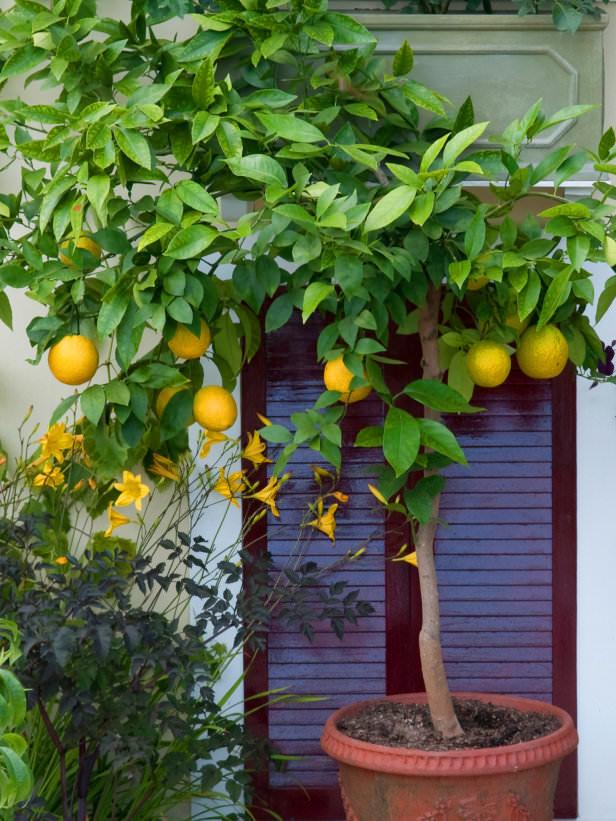
You already know there are many veggies you can grow in pots… Watermelon? You think I’m kidding, don’t ya’? Well jump on over to ‘Gardening Know How‘ and find out how to grow these veggies that are traditionally a space hog, in pots!

You may have seen small decorative bulbs in pots at the nursery, but what about larger bulbs and tubers, like Iris and Dahlias? They can be grown successfully in pots as well. Photo by ‘HGTV‘.
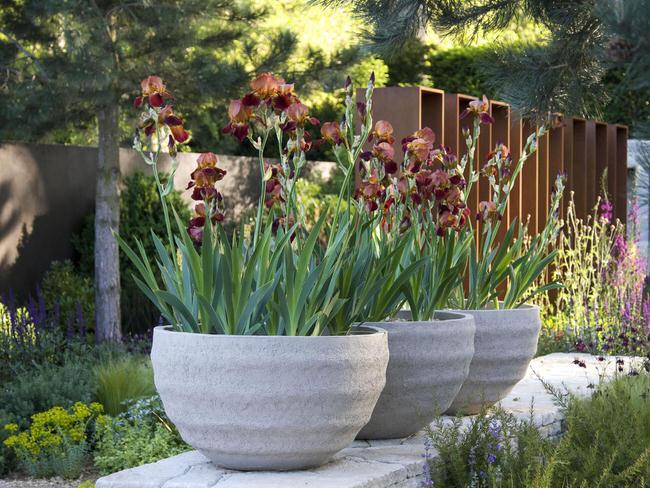
Vines can also grow in pots, you just need to make sure they have proper support. You can either set the pot in front of a wall or trellis, or provide a teepee within the container so that it can be moved when necessary. Photo by Taylors Clematis.
From ‘BHG’, learn how to grow berries in containers. These raspberries and blueberry plants do great when the right varieties are chosen, and they receive enough sun.
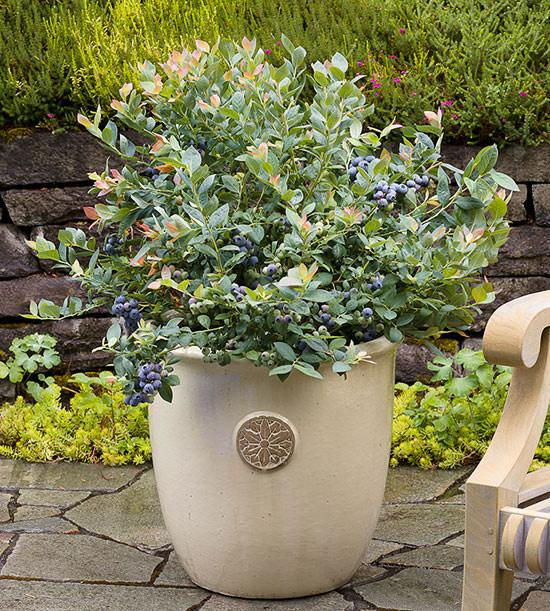
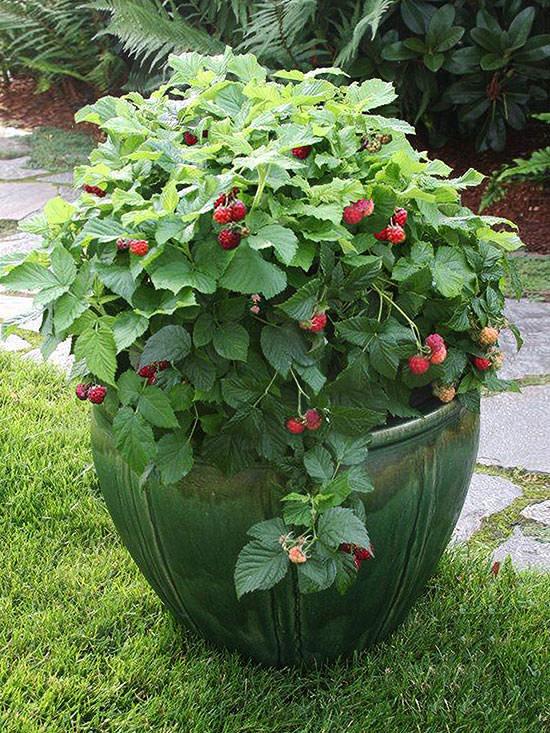
So don’t let the idea of using pots and containers limit you to marigolds and petunias! Use them to your full advantage and try these unexpected plants in containers!
2
0
文章
Mirella
2017年05月23日

Learn how to grow bell peppers in containers. Growing bell peppers in pots is a great idea if you’re short of space or live in a cold temperate climate as it requires warm soil to thrive.
USDA Zones— Pepper plants are short-lived perennials in tropics but in cold temperate regions, they are grown as annual.
Difficulty— Easy
Soil pH— Slightly acidic to neutral
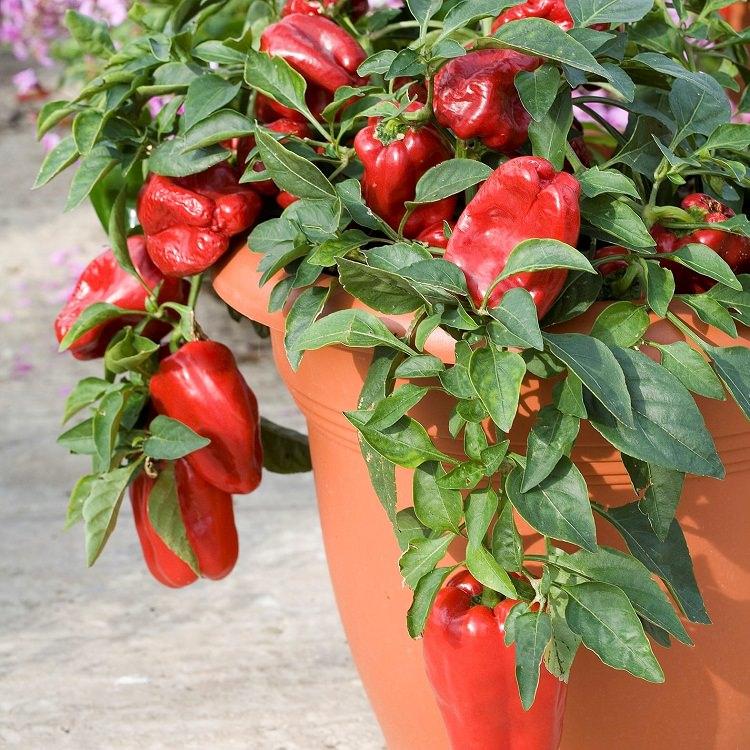
Due to the fact that the pepper is a warm weather vegetable crop and requires considerably more heat than cucumbers and tomatoes, growing bell peppers in pots is a great idea if you live in a cold climate.
How to Grow Bell Peppers in Containers
Growing bell pepper in the pot is easy. The first thing you have to do is to buy the plant from a nursery or propagate it from seeds.
Choosing a Pot
Planting bell pepper in containers requires a pot that is at least 10-12 inches deep and wide and has sufficient drainage holes. You can grow up to 2-3 plants (smaller varieties) in such a pot. Avoid using the black color container if you’re growing bell pepper in a tropical climate.
Propagation
Buy good quality seeds from a local garden store or buy them online. Also, buy seed starting mix or make yourself. Fill small pots or seedling tray with the seed mix and plant two seeds in each pot, 2-3 cm deep.
Start seeds 6-10 weeks before last spring frost date. Usually, in subtropical and tropical climate, you can start seeds anytime except in harsh summer.
The seeds will germinate in 1 to 3 weeks depending on the weather conditions and seed quality. After they germinate thin out and only keep one plant per pot. When seedlings have 2 true leaves they are ready to be transplanted into the desired containers.
Requirements for Growing Bell Pepper in Containers
Position
Peppers love the sun. The most productive pepper plants are grown in warmth and heat. When you’re growing bell peppers in pots, keep them in a position that receives at least 6 hours of sunlight daily. That place should be sheltered from strong wind.
Soil
Good soil is the key to productive pepper plants. Buy best quality potting mix that is well drained, loose and fertile or make your own potting mix. Potting mix must be rich in organic matter. Add well-rotted manure or compost in the combination of peat moss/coco peat and vermiculite or perlite (alternatively, sand). You can also add 5-10 gm neem cake at the time of soil preparation, it will protect the young plant from soil-borne diseases and pests.
Watering
Growing bell peppers require regular watering to keep the soil slightly moist, soil should never dry out completely. In any case, avoid wetting the foliage, overhead watering may cause fungal infection. Water at the foot of the plant. Also, pepper plants suffer from overwatering so be careful that your plants don’t sit in water.
Temperature
Growing bell peppers require soil temperature above 60 F (15 C) for best growth. The optimum seed germination temperature is above 68 F (20 C). It can tolerate temperature up to 95 F (35 C) and down to 50 F (10 C) easily. The ideal growing temperature is between 70-90 F (21-32C).
Bell Pepper CareMulching
For your convenience and to reduce the evaporation of water, do mulching. Cover the base of the plant with organic matter such as leaves, pine barks, straws, paper or whatever that is readily available to you.
Fertilizer
Pepper plants like tomatoes are heavy feeders and you’ll need to fertilize the plant in every 15 days or so. When fertilizing, remember too much nitrogen-rich fertilizer can promote foliage growth. You can also feed the plant with tomato fertilizer. Also, once in a month feed the plant with compost or manure tea. Use of Epsom salt (2tsp/gallon water at the time of watering, you can also spray the plants with this solution) each month improves the health and increases the yield of tomato and pepper plants so it must be applied too.
Pinching and Pruning
In the early stage, when the plant is young pinch growing tips regularly to make it bushier. Pruning is not necessary but can be carried out if required.
Deadheading
If your pepper plant is flowering too early deadhead the flowers, it is important. This will direct the plant’s energy into growing and becoming healthy. You can also stop the formation of new fruits if you want to speed up the maturation of pepper fruits that are already growing on the plant by pinching off emerging flowers.
Pollination
Pepper plants are self-fertile so you don’t need to care about pollination but to get better fruits and to improve productivity you can gently shake the plants when they’re in bloom.

Support
You may need to support the plants. For this, either use tomato cages or simply poke a stick near the main stem and tie the plant to it.
Pests and Diseases
Growing bell peppers in pots require care from aphids as they are the number one enemy of pepper plants. In hot and dry weather you’ll also need to keep an eye on spider mites.
Harvesting
Bell peppers are ready for harvesting in 60-90 days after transplanting. You can harvest them green when they reach full size and remain firm. If left to ripen, the color will change into orange, yellow or red.
A Fact: Pepper is one of the richest sources of Vitamin C (more than the oranges).
USDA Zones— Pepper plants are short-lived perennials in tropics but in cold temperate regions, they are grown as annual.
Difficulty— Easy
Soil pH— Slightly acidic to neutral

Due to the fact that the pepper is a warm weather vegetable crop and requires considerably more heat than cucumbers and tomatoes, growing bell peppers in pots is a great idea if you live in a cold climate.
How to Grow Bell Peppers in Containers
Growing bell pepper in the pot is easy. The first thing you have to do is to buy the plant from a nursery or propagate it from seeds.
Choosing a Pot
Planting bell pepper in containers requires a pot that is at least 10-12 inches deep and wide and has sufficient drainage holes. You can grow up to 2-3 plants (smaller varieties) in such a pot. Avoid using the black color container if you’re growing bell pepper in a tropical climate.
Propagation
Buy good quality seeds from a local garden store or buy them online. Also, buy seed starting mix or make yourself. Fill small pots or seedling tray with the seed mix and plant two seeds in each pot, 2-3 cm deep.
Start seeds 6-10 weeks before last spring frost date. Usually, in subtropical and tropical climate, you can start seeds anytime except in harsh summer.
The seeds will germinate in 1 to 3 weeks depending on the weather conditions and seed quality. After they germinate thin out and only keep one plant per pot. When seedlings have 2 true leaves they are ready to be transplanted into the desired containers.
Requirements for Growing Bell Pepper in Containers

Position
Peppers love the sun. The most productive pepper plants are grown in warmth and heat. When you’re growing bell peppers in pots, keep them in a position that receives at least 6 hours of sunlight daily. That place should be sheltered from strong wind.
Soil
Good soil is the key to productive pepper plants. Buy best quality potting mix that is well drained, loose and fertile or make your own potting mix. Potting mix must be rich in organic matter. Add well-rotted manure or compost in the combination of peat moss/coco peat and vermiculite or perlite (alternatively, sand). You can also add 5-10 gm neem cake at the time of soil preparation, it will protect the young plant from soil-borne diseases and pests.
Watering
Growing bell peppers require regular watering to keep the soil slightly moist, soil should never dry out completely. In any case, avoid wetting the foliage, overhead watering may cause fungal infection. Water at the foot of the plant. Also, pepper plants suffer from overwatering so be careful that your plants don’t sit in water.
Temperature
Growing bell peppers require soil temperature above 60 F (15 C) for best growth. The optimum seed germination temperature is above 68 F (20 C). It can tolerate temperature up to 95 F (35 C) and down to 50 F (10 C) easily. The ideal growing temperature is between 70-90 F (21-32C).
Bell Pepper CareMulching
For your convenience and to reduce the evaporation of water, do mulching. Cover the base of the plant with organic matter such as leaves, pine barks, straws, paper or whatever that is readily available to you.
Fertilizer
Pepper plants like tomatoes are heavy feeders and you’ll need to fertilize the plant in every 15 days or so. When fertilizing, remember too much nitrogen-rich fertilizer can promote foliage growth. You can also feed the plant with tomato fertilizer. Also, once in a month feed the plant with compost or manure tea. Use of Epsom salt (2tsp/gallon water at the time of watering, you can also spray the plants with this solution) each month improves the health and increases the yield of tomato and pepper plants so it must be applied too.
Pinching and Pruning
In the early stage, when the plant is young pinch growing tips regularly to make it bushier. Pruning is not necessary but can be carried out if required.
Deadheading
If your pepper plant is flowering too early deadhead the flowers, it is important. This will direct the plant’s energy into growing and becoming healthy. You can also stop the formation of new fruits if you want to speed up the maturation of pepper fruits that are already growing on the plant by pinching off emerging flowers.
Pollination
Pepper plants are self-fertile so you don’t need to care about pollination but to get better fruits and to improve productivity you can gently shake the plants when they’re in bloom.

Support
You may need to support the plants. For this, either use tomato cages or simply poke a stick near the main stem and tie the plant to it.
Pests and Diseases
Growing bell peppers in pots require care from aphids as they are the number one enemy of pepper plants. In hot and dry weather you’ll also need to keep an eye on spider mites.
Harvesting
Bell peppers are ready for harvesting in 60-90 days after transplanting. You can harvest them green when they reach full size and remain firm. If left to ripen, the color will change into orange, yellow or red.
A Fact: Pepper is one of the richest sources of Vitamin C (more than the oranges).
3
0
文章
粉团
2017年05月22日

Do you want to grow the best tomatoes in taste and size? And want to have a bumper harvest? Then put these things in the hole before planting your tomato plant!
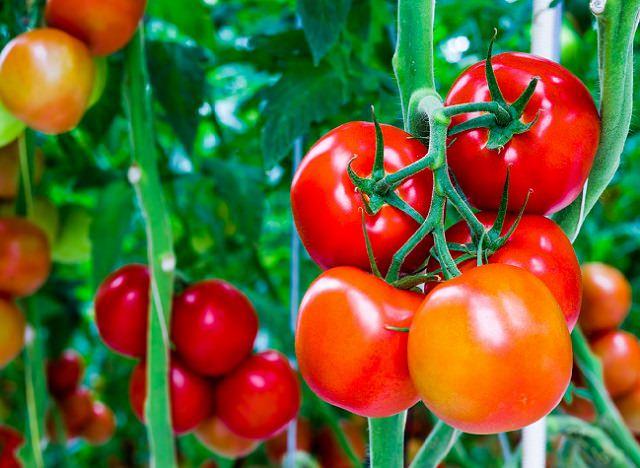
The homegrown TOMATOES are so delicious, and when you pick them fresh and eat, the delightful taste you get is just unmatchable. Better than store bought fruits. The thick, juicy, plump, sweet, a bit acrid and so satiating– the tomatoes are one of the first fruits (vegetable, if you say) everyone wants to grow from the beginning of the gardening season.1. Baking Soda
It works and really a good trick (especially when you’re growing tomatoes in containers) if you want sweeter tomatoes. Simply sprinkle a small amount of baking soda around the base of your tomato plants. The baking soda will be absorbed into the soil and lower the acidity levels, thus, giving you tomatoes that are more sweet than tart.
2. Fish heads
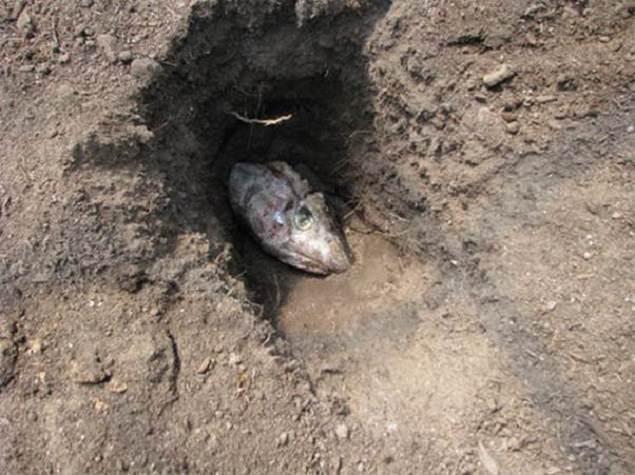
Fish heads have been used as a natural fertilizer in the garden for a long time. Their popularity with tomato planting is not a myth that needs to be busted. It works! Their decay releases nitrogen, potassium, many essential trace elements, calcium and phosphorous. The only problem with burying fish heads is that critters may dig them up. To avoid this, bury deeply, at least a foot. You can drop them into the hole whole or use groundfish scraps which you can mix with water(2 cups) and milk(1 cup) for a supercharge solution. If you want to read more on this, here’s an article in detail!
3. Aspirin
Drop 2-3 aspirin tablets in the hole either whole or ground; this is to boost plant immunity, it also helps to ward off diseases like blight and increases the yield. The salicylic acid, a compound in aspirin is the reason why it works. You can also spray plants with the solution contain this drug. If you want to read more about ASPIRIN uses on tomato plants in detail, visit DailyMail UK.
4. Eggshells
Eggshells boost the calcium content in the soil. And just like us, Calcium is one of the most important components that plant needs for growth. Here’s a very educative article if you like to read, it also helps to prevent blossom end rot. Whether you’re planting tomatoes in the garden bed or containers, you can always put eggshells before planting.
Also Read: Eggshell Uses in the Garden
5. Epsom Salt

Tomatoes suffer from magnesium deficiency that is why it’s a good idea to add 1 or 2 tablespoons of Epsom salt while transplanting the seedling in the bottom of the planting hole (both in containers or garden bed). Cover this with a thin layer of soil; this is to make sure that roots are not directly touching Epsom salt.
Epsom salt must be used when growing tomatoes; it can do miracles. Read why you should use it here!
Also Read: 13 Great Epsom Salt Uses in the Garden
6. Kelp Meal
Kelp meal is rich in micro-nutrients and trace elements. It provides complete nutrient for plants, the addition of kelp gives tomatoes a turbo boosted start. Slow-release kelp fertilizer contains the tomato with sufficient nutrient over a period which prevents the plant from experiencing shock as is with the use of excess fertilizers. One cup-full of kelp meal is adequate for the plant at the time of planting. If you want to read more about kelp fertilizer, click here!
7. Bone Meal
Similar to kelp meal, bone meal is also an addition to the tomato hole during planting. A handful or cup-full of bone meal is essential for a blossoming and quality fruits of the tomato plant since it provides the much-needed phosphorus nutrient which is one of the most vital components for healthy tomato growth.
8. Used coffee grounds

Add well-composted coffee grounds to the planting hole when transplanting tomato seedlings to improve soil composition and provide a source of slow-release nutrients to your plants. It is an excellent source of fertilizer and can be used even as a mulch. We have written a comprehensive guide on coffee grounds uses, take a look!

The homegrown TOMATOES are so delicious, and when you pick them fresh and eat, the delightful taste you get is just unmatchable. Better than store bought fruits. The thick, juicy, plump, sweet, a bit acrid and so satiating– the tomatoes are one of the first fruits (vegetable, if you say) everyone wants to grow from the beginning of the gardening season.1. Baking Soda
It works and really a good trick (especially when you’re growing tomatoes in containers) if you want sweeter tomatoes. Simply sprinkle a small amount of baking soda around the base of your tomato plants. The baking soda will be absorbed into the soil and lower the acidity levels, thus, giving you tomatoes that are more sweet than tart.
2. Fish heads

Fish heads have been used as a natural fertilizer in the garden for a long time. Their popularity with tomato planting is not a myth that needs to be busted. It works! Their decay releases nitrogen, potassium, many essential trace elements, calcium and phosphorous. The only problem with burying fish heads is that critters may dig them up. To avoid this, bury deeply, at least a foot. You can drop them into the hole whole or use groundfish scraps which you can mix with water(2 cups) and milk(1 cup) for a supercharge solution. If you want to read more on this, here’s an article in detail!
3. Aspirin
Drop 2-3 aspirin tablets in the hole either whole or ground; this is to boost plant immunity, it also helps to ward off diseases like blight and increases the yield. The salicylic acid, a compound in aspirin is the reason why it works. You can also spray plants with the solution contain this drug. If you want to read more about ASPIRIN uses on tomato plants in detail, visit DailyMail UK.
4. Eggshells
Eggshells boost the calcium content in the soil. And just like us, Calcium is one of the most important components that plant needs for growth. Here’s a very educative article if you like to read, it also helps to prevent blossom end rot. Whether you’re planting tomatoes in the garden bed or containers, you can always put eggshells before planting.
Also Read: Eggshell Uses in the Garden
5. Epsom Salt

Tomatoes suffer from magnesium deficiency that is why it’s a good idea to add 1 or 2 tablespoons of Epsom salt while transplanting the seedling in the bottom of the planting hole (both in containers or garden bed). Cover this with a thin layer of soil; this is to make sure that roots are not directly touching Epsom salt.
Epsom salt must be used when growing tomatoes; it can do miracles. Read why you should use it here!
Also Read: 13 Great Epsom Salt Uses in the Garden
6. Kelp Meal
Kelp meal is rich in micro-nutrients and trace elements. It provides complete nutrient for plants, the addition of kelp gives tomatoes a turbo boosted start. Slow-release kelp fertilizer contains the tomato with sufficient nutrient over a period which prevents the plant from experiencing shock as is with the use of excess fertilizers. One cup-full of kelp meal is adequate for the plant at the time of planting. If you want to read more about kelp fertilizer, click here!
7. Bone Meal
Similar to kelp meal, bone meal is also an addition to the tomato hole during planting. A handful or cup-full of bone meal is essential for a blossoming and quality fruits of the tomato plant since it provides the much-needed phosphorus nutrient which is one of the most vital components for healthy tomato growth.
8. Used coffee grounds

Add well-composted coffee grounds to the planting hole when transplanting tomato seedlings to improve soil composition and provide a source of slow-release nutrients to your plants. It is an excellent source of fertilizer and can be used even as a mulch. We have written a comprehensive guide on coffee grounds uses, take a look!
0
0
文章
Mirella
2017年05月22日

Learn how to grow bitter melon. Growing bitter gourd is easy. This healthy vegetable grows up quickly and fruits productively. You can also grow it in pots.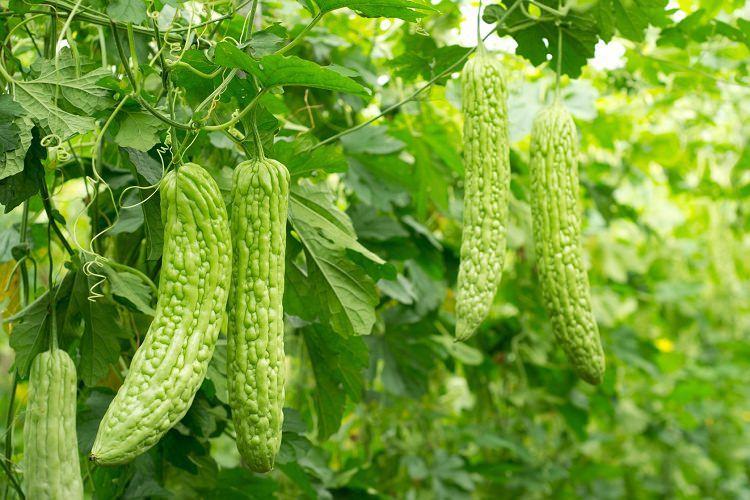
USDA Zones— 6-11
Difficulty— Easy
Other Names— African Cucumber, Ampalaya, Balsam Pear, Balsam-Apple, Balsambirne, Balsamo, Bitter Apple, Bitter Cucumber, Bitter Gourd, Bittergurke, Carilla Fruit, Carilla Gourd, Cerasee, Balsam Pear, Balsam-Apple, Balsambirne, Balsamo, Bitter Apple, Bitter Cucumber, Bitter Gourd, Bittergurke, Carilla Fruit, Carilla Gourd, Cerasee, Chinli-Chih, Cundeamor, Fructus Mormordicae Grosvenori, Karavella, Kathilla, Karela, Kareli, Kerala, Kuguazi, K’u-Kua, Lai Margose, Melón Amargo, Melon Amer, Momordica, Momordica charantia, Momordica murcata, Momordique, Pepino Montero, P’u-T’ao, Sorosi, Sushavi, Vegetable insulin, Wild Cucumber
Bitter Melon is one of the most popular vegetables grown in South-East Asia. Like cucumber, melon or pumpkin it belongs to the gourd family. A native of Indian subcontinent it is used in Asian delicacies. It one of the healthiest vegetables and has many medicinal uses. It has a uniquely bitter and crunchy taste.
Bitter Melon (Bitter Gourd) Information
This very short living tropical perennial climber with thin stems can grow up to 5 m in length. Like other plants of this family, it needs support. Both the stem and lobed leaves are hairy. Bitter melon produces yellow flowers, male or female, which are pollinated by insects.
Bitter taste fruits are eaten unripe when they are still green or slightly pale. They have delicate skin and can be eaten after cooking. Inside there are large seeds. The flesh somewhat resembles a cucumber and is watery and crusty.
How to Grow Bitter MelonPropagation
Seeds can be purchased online or in garden shops. You can also use seeds you get from ripe yellow fruits. Ripe seeds have a crimson red color coat. Germination is not difficult, but there are some tricks to make it faster.
Seeds will germinate slowly in 3-4 weeks if you directly sow them without pre-treatment, especially in low temperatures. But to increase germination rate and for the faster germination, you have to scarify them to remove seed coat. For this, rub the seeds from one side without making any damage to endosperm inside the seed coat. Soaking seeds for 24 hours in water before sowing will also help.
Planting Bitter Melon
Sow seeds 2 cm deep. Seeds can be sown directly into the ground or in the containers but only when the risk of frost has passed and the soil warms up enough. Seeds require the temperature above 70 F (20 C) for germination.
In temperate regions best seed sowing time is summer, usually between late April to May. Whereas in tropics (USDA Zone 10, 11), you can start seeds anytime.
Types and Varieties
There are two types of bitter melons. One from India, which is smaller in size and has spiny skin and the other one is from China. Chinese bitter melons are milder in taste, generally large and smoothly ridged. If you want the higher yield, choose hybrid variety.
How to Grow Bitter Gourd in Pots
Growing bitter gourd (bitter melon) in pots is easy. Similar to squashes, cucumbers, and melons. You’ll need a 12 inches deep pot and a sturdy trellis. However, the bitter melon vine can grow more than 5 m (16 feet) long. A trellis or any other support structure that is at least 5-6 feet tall is required. Once the vine has reached that height you’ll have to redirect it.
Requirements for Growing Bitter Melon
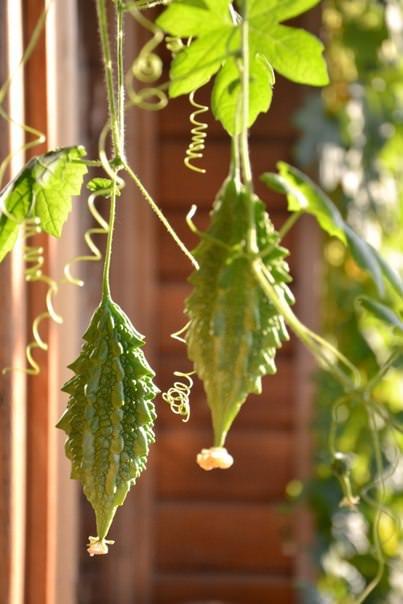
This plant is cultivated in the same way like squashes, melons or cucumbers.
Position
Provide full sun to this vine and it will produce heavily. Also, as it is a tall vine you will need to provide it a support. A tall trellis or a garden fence. If you want to grow it on your patio, terrace or balcony grow it near the wall so that it can go up along with it.
Soil
It tolerates a wide range of soils, but prefers permeable, sandy loam soil that is very rich in organic matter. Bitter melon grows in slightly acidic to slightly alkaline soil. The pH range around 6 to 7.1 is ideal.
Watering
It can tolerate drought like conditions for a short time but regular watering to keep the soil evenly moist is essential to ensure a good yield.
Temperature
In the initial phase of growth, growing bitter gourds require a temperature more than 70 F (20 C). Humid and warm temperature accelerate the growth of the plant. It is more resistant to low temperatures than other plants of this family but requires the hot temperature and humidity to grow.
Bitter Melon Plant CareFertilizer
Overuse of nitrogen-rich fertilizers should be avoided, which could encourage the development of foliage at the expense of fruits. At the time of planting, you can mix slow-release complete fertilizer in the soil. Enriching the soil with compost or well-rotted aged manure and regular inputs of organic matter will be enough later. Still, if your plant is not growing well, you can feed it with liquid vegetable fertilizer once in a month.
Trellising
Bitter gourd perks up very quickly and within two weeks after planting you must arrange something to support it. You can also grow this vine on pergolas, arches or arbor.
Growing bitter gourd vertically increases the yield and fruit size, moreover, in the case of growing horizontally on the ground, there is a high risk of fruit rot and fungal infection to the plant.
Pruning
The plant produces numerous side shoots, which must be removed to improve yield, remove the side shoots (lateral branches) until the runner reaches the top of the trellis. Leave only 4–6 laterals and cut the tip of the main runner to improve the productivity of the plant.
Overwintering
In cooler climates bitter gourds are grown as annual so you may not need to care about overwintering.
Pollination
Pollinators like bees will do the pollination for you so be good to them. If you don’t find pollinators around the flowers you may need to hand pollinate them in the morning.
Pests and Diseases
It is prone to diseases like watermelon mosaic virus, other cucurbit diseases, and powdery mildew. In pests, it gets affected by aphids and spider mites.
Harvesting
Bitter melon starts to fruit quickly in 2 months. Harvest fruits when they are green, little pale and unripe and about the size of 3 to 6 inches (depending more on the variety and type). Within 6 to 8 weeks after the germination, you’ll see the blossoms and in the next 2-3 weeks, fruits will appear and are ready to be picked.

USDA Zones— 6-11
Difficulty— Easy
Other Names— African Cucumber, Ampalaya, Balsam Pear, Balsam-Apple, Balsambirne, Balsamo, Bitter Apple, Bitter Cucumber, Bitter Gourd, Bittergurke, Carilla Fruit, Carilla Gourd, Cerasee, Balsam Pear, Balsam-Apple, Balsambirne, Balsamo, Bitter Apple, Bitter Cucumber, Bitter Gourd, Bittergurke, Carilla Fruit, Carilla Gourd, Cerasee, Chinli-Chih, Cundeamor, Fructus Mormordicae Grosvenori, Karavella, Kathilla, Karela, Kareli, Kerala, Kuguazi, K’u-Kua, Lai Margose, Melón Amargo, Melon Amer, Momordica, Momordica charantia, Momordica murcata, Momordique, Pepino Montero, P’u-T’ao, Sorosi, Sushavi, Vegetable insulin, Wild Cucumber
Bitter Melon is one of the most popular vegetables grown in South-East Asia. Like cucumber, melon or pumpkin it belongs to the gourd family. A native of Indian subcontinent it is used in Asian delicacies. It one of the healthiest vegetables and has many medicinal uses. It has a uniquely bitter and crunchy taste.
Bitter Melon (Bitter Gourd) Information
This very short living tropical perennial climber with thin stems can grow up to 5 m in length. Like other plants of this family, it needs support. Both the stem and lobed leaves are hairy. Bitter melon produces yellow flowers, male or female, which are pollinated by insects.
Bitter taste fruits are eaten unripe when they are still green or slightly pale. They have delicate skin and can be eaten after cooking. Inside there are large seeds. The flesh somewhat resembles a cucumber and is watery and crusty.
How to Grow Bitter MelonPropagation
Seeds can be purchased online or in garden shops. You can also use seeds you get from ripe yellow fruits. Ripe seeds have a crimson red color coat. Germination is not difficult, but there are some tricks to make it faster.
Seeds will germinate slowly in 3-4 weeks if you directly sow them without pre-treatment, especially in low temperatures. But to increase germination rate and for the faster germination, you have to scarify them to remove seed coat. For this, rub the seeds from one side without making any damage to endosperm inside the seed coat. Soaking seeds for 24 hours in water before sowing will also help.
Planting Bitter Melon
Sow seeds 2 cm deep. Seeds can be sown directly into the ground or in the containers but only when the risk of frost has passed and the soil warms up enough. Seeds require the temperature above 70 F (20 C) for germination.
In temperate regions best seed sowing time is summer, usually between late April to May. Whereas in tropics (USDA Zone 10, 11), you can start seeds anytime.
Types and Varieties
There are two types of bitter melons. One from India, which is smaller in size and has spiny skin and the other one is from China. Chinese bitter melons are milder in taste, generally large and smoothly ridged. If you want the higher yield, choose hybrid variety.
How to Grow Bitter Gourd in Pots
Growing bitter gourd (bitter melon) in pots is easy. Similar to squashes, cucumbers, and melons. You’ll need a 12 inches deep pot and a sturdy trellis. However, the bitter melon vine can grow more than 5 m (16 feet) long. A trellis or any other support structure that is at least 5-6 feet tall is required. Once the vine has reached that height you’ll have to redirect it.
Requirements for Growing Bitter Melon

This plant is cultivated in the same way like squashes, melons or cucumbers.
Position
Provide full sun to this vine and it will produce heavily. Also, as it is a tall vine you will need to provide it a support. A tall trellis or a garden fence. If you want to grow it on your patio, terrace or balcony grow it near the wall so that it can go up along with it.
Soil
It tolerates a wide range of soils, but prefers permeable, sandy loam soil that is very rich in organic matter. Bitter melon grows in slightly acidic to slightly alkaline soil. The pH range around 6 to 7.1 is ideal.
Watering
It can tolerate drought like conditions for a short time but regular watering to keep the soil evenly moist is essential to ensure a good yield.
Temperature
In the initial phase of growth, growing bitter gourds require a temperature more than 70 F (20 C). Humid and warm temperature accelerate the growth of the plant. It is more resistant to low temperatures than other plants of this family but requires the hot temperature and humidity to grow.
Bitter Melon Plant CareFertilizer
Overuse of nitrogen-rich fertilizers should be avoided, which could encourage the development of foliage at the expense of fruits. At the time of planting, you can mix slow-release complete fertilizer in the soil. Enriching the soil with compost or well-rotted aged manure and regular inputs of organic matter will be enough later. Still, if your plant is not growing well, you can feed it with liquid vegetable fertilizer once in a month.
Trellising
Bitter gourd perks up very quickly and within two weeks after planting you must arrange something to support it. You can also grow this vine on pergolas, arches or arbor.
Growing bitter gourd vertically increases the yield and fruit size, moreover, in the case of growing horizontally on the ground, there is a high risk of fruit rot and fungal infection to the plant.
Pruning
The plant produces numerous side shoots, which must be removed to improve yield, remove the side shoots (lateral branches) until the runner reaches the top of the trellis. Leave only 4–6 laterals and cut the tip of the main runner to improve the productivity of the plant.
Overwintering
In cooler climates bitter gourds are grown as annual so you may not need to care about overwintering.
Pollination
Pollinators like bees will do the pollination for you so be good to them. If you don’t find pollinators around the flowers you may need to hand pollinate them in the morning.
Pests and Diseases
It is prone to diseases like watermelon mosaic virus, other cucurbit diseases, and powdery mildew. In pests, it gets affected by aphids and spider mites.
Harvesting
Bitter melon starts to fruit quickly in 2 months. Harvest fruits when they are green, little pale and unripe and about the size of 3 to 6 inches (depending more on the variety and type). Within 6 to 8 weeks after the germination, you’ll see the blossoms and in the next 2-3 weeks, fruits will appear and are ready to be picked.
0
0
文章
Martha
2017年05月22日

Learn how to grow pumpkins in pots, growing pumpkins in containers and pots is not difficult though it requires large containers and space. Check out!

Pumpkin is valued for its flavor and decorative appearance. Growing pumpkin in pots is not so difficult and does not require special care and in fact, it is a less demanding vegetable that adapts to any climate. Basically, an annual plant in the temperate zones, perennial in tropical ones.
Must Read: Growing Cucumbers
Planting
You can grow pumpkins from seeds or else buy seedlings from a nursery. Best planting time for growing pumpkins is when the temperature exceeds above 65 F. In cooler climates it can be planted from April to late May. Whereas, in much warmer climates, it can be done until July. Moreover, if you live in a frost-free subtropical or tropical climate, you can grow it almost all the year.
Choosing a pot
Choose a large pot that is 10 gallons in size (for small pumpkin varieties), if you’re growing pumpkins in pots. For large cultivars, the bigger the pot the better, a 15-25-gallon pot that is 20-24 inches deep and wide is required. Also, ensure there is adequate drainage available to your pumpkin plants.
Small Pumpkin Varieties
Small pumpkin varieties like ‘Jack be little’, ‘Wee be little’, ‘Baby boo’, ‘Munchkin’, Pumpkin Hooligan’, ‘Mini-jack’, ‘Lil pump ke mon’ are most suitable for container gardening. However, you can also grow giant pumpkin varieties.
Requirements for Growing Pumpkins in Pots
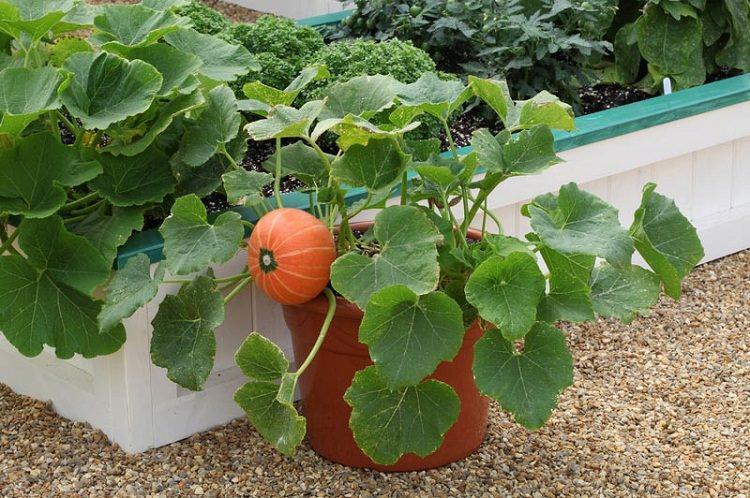
Position
Place it in the sunniest location possible; remember that even the smallest pumpkin varieties need lots of sunlight to grow. Your plant should receive at least six hours of sunlight per day. The shadow will slow their growth and moisture will remain on the plant, thus resulting the mildew.
Also, pumpkin needs a warm climate and plenty of room for growth. Still, you can even try growing dwarf pumpkins on a balcony or roof garden. Even if growing in a limited space, provide proper air circulation around the plant.
Soil
In cold climates, pumpkins grow best in a soil that heats up easily. Potting mix you use must be well-draining, have high humus content and slight water retaining capacity, too. Also, pumpkins require a lot of compost or manure, so additionally at the time of planting, you can add a lot of organic content. The ideal soil pH for growing pumpkins should be around 6 – 7.2.
Watering
Like all the gourds and melons, pumpkins require plenty of water and moist soil, so deep and regular watering is essential. Always, at the time of watering, avoid wetting the foliage.
Must Read: How to Grow Watermelon in Pot
Support
You’ll need to install a strong and big trellis to support pumpkins vines. An A-shape trellis is good one. Make sure to keep the trellis away from the wall to avoid diseases. As the pumpkin vine begins to grow, train it to climb on the structure by carefully moving it through it.
Pumpkin Plant Care

Mulching
Do mulching, once your plants are grown a few inches tall. Mulching will reduce the amount of water evaporate and helps in retaining the soil moisture.
Fertilizer
Pumpkin plants are heavy feeders, they require a lot of fertilization. First of all, it’s important to have rich and fertile soil to get bigger and more meaty pumpkins. Best to use 10-10-10 balanced fertilizer in the early stage of growth. Later, the amount of nitrogen to be applied must be reduced. Switching to a low nitrogen fertilizer that is rich in potassium and phosphorus like 5-15-15 fertilizer in every other week (when the plant has grown and big enough to produce flowers) is a good idea.
Pests and Diseases
Pumpkin is a robust plant still it suffers from a few diseases, especially powdery mildew. In pests, you should keep eyes on common garden pests like aphids, flea beetles, and worms.
Harvesting
Pumpkins are ready for harvest within 90-120 days after planting (depending on the varieties and growing conditions). Green and unripe pumpkins are also picked to use in recipes and in many cuisines. But to pick matured pumpkins, see if it hardens and takes on a uniform and intense color (orange for most common varieties). Press the pumpkin with your thumb; If the bark is hard and it sounds hollow, it is the time to pick the fruit. The bark should also resist the nail pressure. Roughly speaking, one must count about 100 days between planting pumpkin and harvest at full maturity.
To pick the pumpkin, remove it carefully from the branch using pruning shears or a sharp knife. Do not cut too close to the fruit, however; to extend the shelf life, leave a long stem (about 10 cm). Store your pumpkin in a dry, cool and dark area.
A Few TipsIt is better if you’ll plant pumpkins directly in pots. If sowing seeds indoors, choose biodegradable pots, this way you’ll be able to transplant the seedlings without disturbing the roots.Male flowers start to bloom first, they attract pollinators and last one day. After that female flowers open, these have a small swelling at the base of the bloom.If there are no bees or other pollinators, to allow the plant to set fruits and to get the ample harvest, you may need to hand pollinate the male and female flowers.Don’t allow the plant to set too many fruits.As the fruits are heavy you’ll need to support them from netting or old stockings.

Pumpkin is valued for its flavor and decorative appearance. Growing pumpkin in pots is not so difficult and does not require special care and in fact, it is a less demanding vegetable that adapts to any climate. Basically, an annual plant in the temperate zones, perennial in tropical ones.
Must Read: Growing Cucumbers
Planting
You can grow pumpkins from seeds or else buy seedlings from a nursery. Best planting time for growing pumpkins is when the temperature exceeds above 65 F. In cooler climates it can be planted from April to late May. Whereas, in much warmer climates, it can be done until July. Moreover, if you live in a frost-free subtropical or tropical climate, you can grow it almost all the year.
Choosing a pot
Choose a large pot that is 10 gallons in size (for small pumpkin varieties), if you’re growing pumpkins in pots. For large cultivars, the bigger the pot the better, a 15-25-gallon pot that is 20-24 inches deep and wide is required. Also, ensure there is adequate drainage available to your pumpkin plants.
Small Pumpkin Varieties
Small pumpkin varieties like ‘Jack be little’, ‘Wee be little’, ‘Baby boo’, ‘Munchkin’, Pumpkin Hooligan’, ‘Mini-jack’, ‘Lil pump ke mon’ are most suitable for container gardening. However, you can also grow giant pumpkin varieties.
Requirements for Growing Pumpkins in Pots

Position
Place it in the sunniest location possible; remember that even the smallest pumpkin varieties need lots of sunlight to grow. Your plant should receive at least six hours of sunlight per day. The shadow will slow their growth and moisture will remain on the plant, thus resulting the mildew.
Also, pumpkin needs a warm climate and plenty of room for growth. Still, you can even try growing dwarf pumpkins on a balcony or roof garden. Even if growing in a limited space, provide proper air circulation around the plant.
Soil
In cold climates, pumpkins grow best in a soil that heats up easily. Potting mix you use must be well-draining, have high humus content and slight water retaining capacity, too. Also, pumpkins require a lot of compost or manure, so additionally at the time of planting, you can add a lot of organic content. The ideal soil pH for growing pumpkins should be around 6 – 7.2.
Watering
Like all the gourds and melons, pumpkins require plenty of water and moist soil, so deep and regular watering is essential. Always, at the time of watering, avoid wetting the foliage.
Must Read: How to Grow Watermelon in Pot
Support
You’ll need to install a strong and big trellis to support pumpkins vines. An A-shape trellis is good one. Make sure to keep the trellis away from the wall to avoid diseases. As the pumpkin vine begins to grow, train it to climb on the structure by carefully moving it through it.
Pumpkin Plant Care

Mulching
Do mulching, once your plants are grown a few inches tall. Mulching will reduce the amount of water evaporate and helps in retaining the soil moisture.
Fertilizer
Pumpkin plants are heavy feeders, they require a lot of fertilization. First of all, it’s important to have rich and fertile soil to get bigger and more meaty pumpkins. Best to use 10-10-10 balanced fertilizer in the early stage of growth. Later, the amount of nitrogen to be applied must be reduced. Switching to a low nitrogen fertilizer that is rich in potassium and phosphorus like 5-15-15 fertilizer in every other week (when the plant has grown and big enough to produce flowers) is a good idea.
Pests and Diseases
Pumpkin is a robust plant still it suffers from a few diseases, especially powdery mildew. In pests, you should keep eyes on common garden pests like aphids, flea beetles, and worms.
Harvesting
Pumpkins are ready for harvest within 90-120 days after planting (depending on the varieties and growing conditions). Green and unripe pumpkins are also picked to use in recipes and in many cuisines. But to pick matured pumpkins, see if it hardens and takes on a uniform and intense color (orange for most common varieties). Press the pumpkin with your thumb; If the bark is hard and it sounds hollow, it is the time to pick the fruit. The bark should also resist the nail pressure. Roughly speaking, one must count about 100 days between planting pumpkin and harvest at full maturity.
To pick the pumpkin, remove it carefully from the branch using pruning shears or a sharp knife. Do not cut too close to the fruit, however; to extend the shelf life, leave a long stem (about 10 cm). Store your pumpkin in a dry, cool and dark area.
A Few TipsIt is better if you’ll plant pumpkins directly in pots. If sowing seeds indoors, choose biodegradable pots, this way you’ll be able to transplant the seedlings without disturbing the roots.Male flowers start to bloom first, they attract pollinators and last one day. After that female flowers open, these have a small swelling at the base of the bloom.If there are no bees or other pollinators, to allow the plant to set fruits and to get the ample harvest, you may need to hand pollinate the male and female flowers.Don’t allow the plant to set too many fruits.As the fruits are heavy you’ll need to support them from netting or old stockings.
1
0
文章
Martha
2017年05月22日

In this article, learn how to grow pinto beans. The easy growing pinto beans are nutrient rich and eating them can reduce the cholesterol level and risk of heart disease.
USDA Zones— 5 – 11
Difficulty— Easy
Other names — Phaseolus vulgaris var. pinto (Scientific Name)Frijol pinto, Speckled bean, Poroto frutilla, Strawberry bean, Carioca bean, Mottled bean, Phaseolus vulgaris and Common beans.
Pinto beans are annual plants that grow best in areas with long hot summers as they take three to five months to mature for harvest.
How to Grow Pinto BeansVarieties
Pinto beans grow on both vine (pole) and bush. Pole bean varieties produce more yield than bush beans. But bushier varieties are relatively easy to grow.
Propagation
Sow seeds 1 inches deep in the soil when all the dangers of frost are passed. *Pinto beans require direct seed sowing as they are not easy to transplant. Also, remember that it is a subtropical plant and needs a temperature around 60 – 70 F (16 – 21 C) for germination. Space pinto bean seeds 3-4 inches apart in rows that are 2 to 3 feet apart. *Soak the seeds for 24 hours before planting to accelerate germination.
Location
Choose the sunniest spot in the garden that is less windy. For optimum growth, growing pinto beans in full sun is important. It needs at least six hours of direct sun a day but grows better if receive more sun.
Also Read: How to Grow Cluster Beans
Requirements for Growing Pinto BeansSoil
Pinto Beans do best in well-drained soil that is loamy, avoid clay-rich, heavy or soggy soil. Soil that is waterlogging causes root rot.
Watering
Water the plant only when top one inch of surface seems dry. Avoid overwatering because it does not tolerate excessive moisture but handle a bit of drought. Also, try not to wet the foliage while watering as it may promote fungal diseases.
Weeding
Keep the location weed free by gently pulling out the weeds around the plants by hand. Better not to use a tool as pinto beans have shallow roots that can be damaged by weeding with the help of tools.
Mulching
Since pinto beans have shallow feeder roots, it is best to do mulching to stop weeds from growing. Mulching also protects the plants from the cold.
Fertilizer
For growing pinto beans you’ll require low nitrogen fertilizer, legumes produce their own nitrogen and applying too much nitrogen can also result in comparatively more vegetative growth than fruits.
It needs fertilizer application twice for better yield. Admix 5-10-10 slow release fertilizer in the first 6 inches of the planting bed after the germination. Make sure not to apply fertilizer in 2 inches radius around the seedlings as it may damage them. Make a second application of 10-20-20 fertilizer when the plant begins to flowers.
Pests and Diseases
Its main problem is root rot, which you can easily prevent by moderate watering.
Pinto beans are sometimes attacked by aphids, spider mites, whiteflies, leafhoppers, and beetles. Use organic sprays to get rid of them or handpick if the infection is small. You can also invite beneficial insects into your garden to get rid of them.
Also Read: Plants that Attract Ladybugs
Harvesting
Pinto beans are ready for harvest within 90 to 120 days after planting. Harvest pinto beans by cutting the pods using clean scissors or pruning shear when they turn brown and become brittle and dry. You can also harvest the beans early if you want to use them green.

USDA Zones— 5 – 11
Difficulty— Easy
Other names — Phaseolus vulgaris var. pinto (Scientific Name)Frijol pinto, Speckled bean, Poroto frutilla, Strawberry bean, Carioca bean, Mottled bean, Phaseolus vulgaris and Common beans.
Pinto beans are annual plants that grow best in areas with long hot summers as they take three to five months to mature for harvest.
How to Grow Pinto BeansVarieties
Pinto beans grow on both vine (pole) and bush. Pole bean varieties produce more yield than bush beans. But bushier varieties are relatively easy to grow.
Propagation
Sow seeds 1 inches deep in the soil when all the dangers of frost are passed. *Pinto beans require direct seed sowing as they are not easy to transplant. Also, remember that it is a subtropical plant and needs a temperature around 60 – 70 F (16 – 21 C) for germination. Space pinto bean seeds 3-4 inches apart in rows that are 2 to 3 feet apart. *Soak the seeds for 24 hours before planting to accelerate germination.
Location
Choose the sunniest spot in the garden that is less windy. For optimum growth, growing pinto beans in full sun is important. It needs at least six hours of direct sun a day but grows better if receive more sun.
Also Read: How to Grow Cluster Beans
Requirements for Growing Pinto BeansSoil
Pinto Beans do best in well-drained soil that is loamy, avoid clay-rich, heavy or soggy soil. Soil that is waterlogging causes root rot.
Watering
Water the plant only when top one inch of surface seems dry. Avoid overwatering because it does not tolerate excessive moisture but handle a bit of drought. Also, try not to wet the foliage while watering as it may promote fungal diseases.
Weeding
Keep the location weed free by gently pulling out the weeds around the plants by hand. Better not to use a tool as pinto beans have shallow roots that can be damaged by weeding with the help of tools.
Mulching
Since pinto beans have shallow feeder roots, it is best to do mulching to stop weeds from growing. Mulching also protects the plants from the cold.
Fertilizer
For growing pinto beans you’ll require low nitrogen fertilizer, legumes produce their own nitrogen and applying too much nitrogen can also result in comparatively more vegetative growth than fruits.
It needs fertilizer application twice for better yield. Admix 5-10-10 slow release fertilizer in the first 6 inches of the planting bed after the germination. Make sure not to apply fertilizer in 2 inches radius around the seedlings as it may damage them. Make a second application of 10-20-20 fertilizer when the plant begins to flowers.
Pests and Diseases
Its main problem is root rot, which you can easily prevent by moderate watering.
Pinto beans are sometimes attacked by aphids, spider mites, whiteflies, leafhoppers, and beetles. Use organic sprays to get rid of them or handpick if the infection is small. You can also invite beneficial insects into your garden to get rid of them.
Also Read: Plants that Attract Ladybugs
Harvesting
Pinto beans are ready for harvest within 90 to 120 days after planting. Harvest pinto beans by cutting the pods using clean scissors or pruning shear when they turn brown and become brittle and dry. You can also harvest the beans early if you want to use them green.
0
0
文章
Martha
2017年05月22日

Learn how to grow romanesco, growing romanesco broccoli is rewarding. It is a very decorative and ornamental cauliflower with exotic taste.
USDA Zones — 3 – 11
Propagation Method — Seeds
Difficulty — Moderate
Other Names — Brassica oleracea botrytis (latin name), Romanesco broccoli Romanesco Cauliflower, Romanesque cauliflower, Buzzy Broc
Romanesco broccoli is also called “Broccoli Apple” and “Cauliflower with Turrets”. It is a Mediterranean plant, native to Italy, especially of Rome and is an Italian cousin of broccoli and cauliflower.
It is a very decorative and ornamental cauliflower with exotic taste. You can even grow it in the flower garden and admire it.
Romanesco is rich in vitamin C and minerals. It has a mild taste than other cauliflowers and slightly sweet flavor.
Planting
Seed sowing is done in spring and summer. If growing romanesco in cooler zones, sow the seeds 4 – 6 weeks prior to planting outside. Sow the seeds 2 cm deep. While planting the seedlings outside leave 50 cm (2 feet) of space in all directions.
If growing in subtropical and tropical zones you can plant it in fall or in winter.
Companion Plants
Dill, artichokes, chard, beet, borage, chamomile, nasturtium, carrot, celery, cucumber, spinach, beans, hyssop, lettuce, mint, marigold, oregano, peas, potatoes, rosemary, sage, thyme.
Incompatible Plants
Garlic, chives, shallots, strawberries, turnip, onion, parsnip, leek, radish, rutabaga, tomatoes.
Requirements for Growing RomanescoSoil
Humus and compost rich soil that is well drained is recommended.
Sun
Growing romanesco in sunny spot for more yield.
Watering
Like most of the brassicas it enjoys frequent and regular watering.
Romanesco Care
Romanesco broccoli care is similar to other cauliflowers and cabbages.
Fertilizer
Mix compost and 10 – 10 – 10 slow release fertilizer at the time of planting. Fertilize it with high in nitrogen fertilizer one month after planting.
Mulching
Do mulching to keep the soil weed free and conserve moisture.
Pests and Diseases
Flea beetles, gall weevil, whiteflie, aphids and moths. Snails and slugs are fond of seedlings. Besides this it is infected by blight, clubroot and mildew.
Harvesting
Generally, romanesco is ready to harvest in 75 – 100 days after planting. Pick the head when they are tight and dense and use fresh as soon as possible.
Crop rotation

USDA Zones — 3 – 11
Propagation Method — Seeds
Difficulty — Moderate
Other Names — Brassica oleracea botrytis (latin name), Romanesco broccoli Romanesco Cauliflower, Romanesque cauliflower, Buzzy Broc
Romanesco broccoli is also called “Broccoli Apple” and “Cauliflower with Turrets”. It is a Mediterranean plant, native to Italy, especially of Rome and is an Italian cousin of broccoli and cauliflower.
It is a very decorative and ornamental cauliflower with exotic taste. You can even grow it in the flower garden and admire it.
Romanesco is rich in vitamin C and minerals. It has a mild taste than other cauliflowers and slightly sweet flavor.
Planting
Seed sowing is done in spring and summer. If growing romanesco in cooler zones, sow the seeds 4 – 6 weeks prior to planting outside. Sow the seeds 2 cm deep. While planting the seedlings outside leave 50 cm (2 feet) of space in all directions.
If growing in subtropical and tropical zones you can plant it in fall or in winter.
Companion Plants
Dill, artichokes, chard, beet, borage, chamomile, nasturtium, carrot, celery, cucumber, spinach, beans, hyssop, lettuce, mint, marigold, oregano, peas, potatoes, rosemary, sage, thyme.
Incompatible Plants
Garlic, chives, shallots, strawberries, turnip, onion, parsnip, leek, radish, rutabaga, tomatoes.
Requirements for Growing RomanescoSoil
Humus and compost rich soil that is well drained is recommended.
Sun
Growing romanesco in sunny spot for more yield.
Watering
Like most of the brassicas it enjoys frequent and regular watering.
Romanesco Care
Romanesco broccoli care is similar to other cauliflowers and cabbages.
Fertilizer
Mix compost and 10 – 10 – 10 slow release fertilizer at the time of planting. Fertilize it with high in nitrogen fertilizer one month after planting.
Mulching
Do mulching to keep the soil weed free and conserve moisture.
Pests and Diseases
Flea beetles, gall weevil, whiteflie, aphids and moths. Snails and slugs are fond of seedlings. Besides this it is infected by blight, clubroot and mildew.
Harvesting
Generally, romanesco is ready to harvest in 75 – 100 days after planting. Pick the head when they are tight and dense and use fresh as soon as possible.
Crop rotation
0
0
文章
Mirella
2017年05月22日

Learn how to spinach in pots, it is one of the vegetables that you can grow in some shade and in any kind of space. Growing spinach in containers is easy too you can even grow it indoors on a windowsill.
USDA Zones— 3 – 11
Difficulty— Easy
Other Names— Spinacia oleracea (Scientific Name), Persian vegetable, palak, bōsī cài, 波斯菜, leafy greens
How to Grow Spinach in Pots
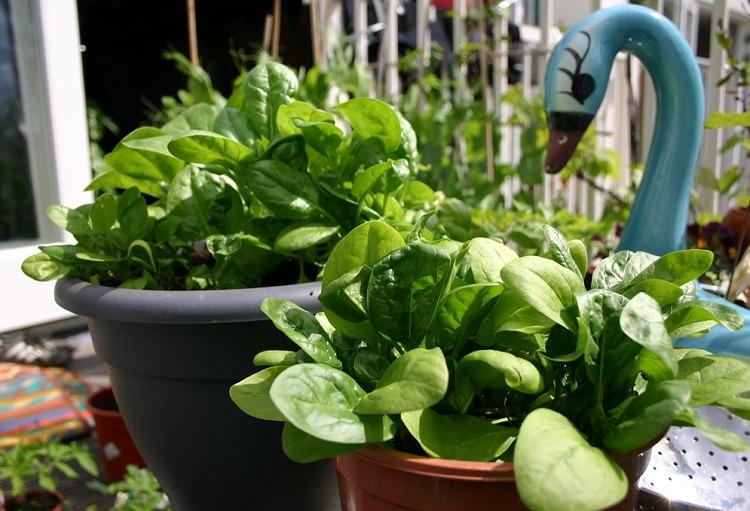
Growing Spinach in Pots from Seeds
Sow seeds 1/2 inches deep directly in containers or in a seed tray. Seedlings will germinate in 5-14 days depending on the variety and growing conditions. If you have sown seeds in a seed tray wait until 2-3 true leaves appear in each plant and then transplant them into the original pots carefully.
Choosing a pot
For growing spinach in pots, choose a pot that is least 6-8 inches deep. You don’t need a very deep pot rather use a wide pot. You can either use so many small pots and grow one plant in each or select large window boxes, wooden boxes or crates.
Spacing
Provide each spinach plant a space of 3 inches, if you want to pick large leaves give more space to each plant, 5 inches. If you want to harvest leaves at very young age, then this area can be reduced to 2 inches only. Divide the planter box into squares, and see how many plants will feel comfortable in it.
Requirements for Growing Spinach in ContainersPosition
If you are growing spinach in fall (autumn), keep the plant in a sunny spot (in mild climates) due to shorter days and less intensity of the sun. For spring and summer planting keep your potted plants in a location where it receives some shade, especially in the afternoon. In subtropical or tropical climate, place the containers in a spot that receives plenty of shade.
Soil
For growing spinach in containers, use quality potting mix rich in organic matter. The texture of soil must be crumbly and loamy. Avoid soil that clogs the drainage and remains waterlogged. Well-draining soil is most important factor for the optimum growth of spinach in containers. Soil pH must be neutral.
Watering
When growing spinach in containers avoid water stagnation because it will lead to the development of rot and various fungal diseases. Also, avoid wetting the foliage. Keep the soil moist but not soggy or wet. It is necessary to take care of good drainage in the pot.
Temperature
Spinach seeds germinate in temperatures as low as 40 F (4 C) and in high temperatures too. The best soil temperature for growing spinach falls in the range of 50-80 F (10-27 C). Many spinach cultivars can tolerate temperature down to 20 F (-6) and up to 90 F (32 C) easily. Once the temperature starts to soar high you may need to provide shade to your plants.
Growing Spinach Indoors

Growing spinach indoors on a windowsill is a great idea (as it doesn’t require a lot of sunlight) if you’re short of outdoor space. For this, buy a few 6 inches deep small pots and grow spinach in them. You can also grow herbs and annual flowers there.
Also Read: How to Make a Windowsill Herb Garden
Spinach Care
Growing spinach in pots doesn’t need special care. Regular watering, fertilizing and the right soil is the key to the great harvest.
Fertilizing
For growing healthy green spinach, you have to provide nitrogen. At the time of planting, you can mix time-based fertilizer or you can add a lot of compost or well-rotted manure, this will provide nutrients slowly. Feeding the plant with fish emulsion, compost or manure tea in the middle of the growth and so on is a nice organic way to promote the plants. If you have not done added time-based fertilizer, you can also feed the plant with balanced liquid fertilizer at regular intervals.
Mulching
Do mulching, even if you’re growing spinach in pots. Mulching plants with organic matter will help in retaining moisture.
Pests and Diseases
You don’t need to worry much about pests as you’re growing spinach in containers, in a small space and you can easily control them. However, keeping an eye on leaf-eating insects like slugs and caterpillars and other common garden pests like aphids will help you in eliminating them in time.
A Few Tips for Growing Spinach in Tropics
It is a cool season crop but growing spinach in tropics and subtropics is extremely easy, moreover, you can grow it successively as a bi-annual crop, except in hot summer months. You’ll need to provide it shade and enough water to keep the soil temperature cool and moist.
In warm weather, vegetables like lettuce and spinach begin to bolt early and start to set seeds. One of the most important thing you need to consider when growing spinach in tropics is to grow heat tolerant varieties (there are a lot of Asian varieties that are suitable for tropical climate) that grow slowly and do not bolt quickly. These varieties easily tolerate the heat and humidity.
Harvesting
The spinach plant will be ready for harvest 37-50 days after germination depending on the growing conditions and cultivar.
Harvesting can be done when the plant has formed at least 5-6 healthy leaves and they are at least 3-4 inches long. Pick outer leaves first and leave the new inner leaves so that they continue to grow or cut the whole plant off at the base with a knife or scissor, the plant will resprout again.
When the weather becomes humid and hot (in warm climates) the plant tends to form an erect stem, on which you can see some small yellow or green flowers developing. To coincide with the flowering and the subsequent production of flowers, the foliage of the plant thickens and changes in flavor (more bitter), which is called bolting so it is convenient to harvest the plant before it starts flowering for better taste.
USDA Zones— 3 – 11
Difficulty— Easy
Other Names— Spinacia oleracea (Scientific Name), Persian vegetable, palak, bōsī cài, 波斯菜, leafy greens
How to Grow Spinach in Pots

Growing Spinach in Pots from Seeds
Sow seeds 1/2 inches deep directly in containers or in a seed tray. Seedlings will germinate in 5-14 days depending on the variety and growing conditions. If you have sown seeds in a seed tray wait until 2-3 true leaves appear in each plant and then transplant them into the original pots carefully.
Choosing a pot
For growing spinach in pots, choose a pot that is least 6-8 inches deep. You don’t need a very deep pot rather use a wide pot. You can either use so many small pots and grow one plant in each or select large window boxes, wooden boxes or crates.
Spacing
Provide each spinach plant a space of 3 inches, if you want to pick large leaves give more space to each plant, 5 inches. If you want to harvest leaves at very young age, then this area can be reduced to 2 inches only. Divide the planter box into squares, and see how many plants will feel comfortable in it.
Requirements for Growing Spinach in ContainersPosition
If you are growing spinach in fall (autumn), keep the plant in a sunny spot (in mild climates) due to shorter days and less intensity of the sun. For spring and summer planting keep your potted plants in a location where it receives some shade, especially in the afternoon. In subtropical or tropical climate, place the containers in a spot that receives plenty of shade.
Soil
For growing spinach in containers, use quality potting mix rich in organic matter. The texture of soil must be crumbly and loamy. Avoid soil that clogs the drainage and remains waterlogged. Well-draining soil is most important factor for the optimum growth of spinach in containers. Soil pH must be neutral.
Watering
When growing spinach in containers avoid water stagnation because it will lead to the development of rot and various fungal diseases. Also, avoid wetting the foliage. Keep the soil moist but not soggy or wet. It is necessary to take care of good drainage in the pot.
Temperature
Spinach seeds germinate in temperatures as low as 40 F (4 C) and in high temperatures too. The best soil temperature for growing spinach falls in the range of 50-80 F (10-27 C). Many spinach cultivars can tolerate temperature down to 20 F (-6) and up to 90 F (32 C) easily. Once the temperature starts to soar high you may need to provide shade to your plants.
Growing Spinach Indoors

Growing spinach indoors on a windowsill is a great idea (as it doesn’t require a lot of sunlight) if you’re short of outdoor space. For this, buy a few 6 inches deep small pots and grow spinach in them. You can also grow herbs and annual flowers there.
Also Read: How to Make a Windowsill Herb Garden
Spinach Care
Growing spinach in pots doesn’t need special care. Regular watering, fertilizing and the right soil is the key to the great harvest.
Fertilizing
For growing healthy green spinach, you have to provide nitrogen. At the time of planting, you can mix time-based fertilizer or you can add a lot of compost or well-rotted manure, this will provide nutrients slowly. Feeding the plant with fish emulsion, compost or manure tea in the middle of the growth and so on is a nice organic way to promote the plants. If you have not done added time-based fertilizer, you can also feed the plant with balanced liquid fertilizer at regular intervals.
Mulching
Do mulching, even if you’re growing spinach in pots. Mulching plants with organic matter will help in retaining moisture.
Pests and Diseases
You don’t need to worry much about pests as you’re growing spinach in containers, in a small space and you can easily control them. However, keeping an eye on leaf-eating insects like slugs and caterpillars and other common garden pests like aphids will help you in eliminating them in time.
A Few Tips for Growing Spinach in Tropics
It is a cool season crop but growing spinach in tropics and subtropics is extremely easy, moreover, you can grow it successively as a bi-annual crop, except in hot summer months. You’ll need to provide it shade and enough water to keep the soil temperature cool and moist.
In warm weather, vegetables like lettuce and spinach begin to bolt early and start to set seeds. One of the most important thing you need to consider when growing spinach in tropics is to grow heat tolerant varieties (there are a lot of Asian varieties that are suitable for tropical climate) that grow slowly and do not bolt quickly. These varieties easily tolerate the heat and humidity.
Harvesting
The spinach plant will be ready for harvest 37-50 days after germination depending on the growing conditions and cultivar.
Harvesting can be done when the plant has formed at least 5-6 healthy leaves and they are at least 3-4 inches long. Pick outer leaves first and leave the new inner leaves so that they continue to grow or cut the whole plant off at the base with a knife or scissor, the plant will resprout again.
When the weather becomes humid and hot (in warm climates) the plant tends to form an erect stem, on which you can see some small yellow or green flowers developing. To coincide with the flowering and the subsequent production of flowers, the foliage of the plant thickens and changes in flavor (more bitter), which is called bolting so it is convenient to harvest the plant before it starts flowering for better taste.
0
0
文章
Mirella
2017年05月22日

Learn how to grow cauliflower in containers in this article. Growing cauliflowers in containers is not very difficult if you know its proper requirements and ideal growing conditions.

However, cauliflower is a cool season crop but there are many hybrid cultivars available for both temperate and tropical weather, which means it can be grown diversely in a variety of climates.
How to Grow Cauliflower in ContainersPlanting cauliflower in containers
It is important to plant the variety that fits the season and climate you are living in. Cauliflowers can be planted anytime in frost free climate when the temperature is in the range of 50-85 F (10 C to 30 C). At the time when heads are maturing, the ideal temperature is around 60-70 F (15-20 C).
Generally, in warmer regions (USDA Zone 9 – 11), you can start to sow cauliflower seeds in fall and continue to sow the seeds until the end of winter. In cooler zones, it is better to sow the seeds until late winter and up to spring to get summer or fall harvest.
Propagation
Sowing, transplanting, and planting is same as for the cabbages. Sow the seeds in a seed starting mix, 1 or 2 cm deep and 4 cm apart. Once the seedlings germinated and plants have 3 or 4 leaves, you can start growing cauliflower in containers.
Choosing a Container
Choose a pot that is 12 inches deep and at least 10 inches wide to allow enough room for a plant to grow. Also, make sure it has enough drainage holes in the bottom. In such a pot you can grow one plant.
You can also grow 2-3 cauliflower plants together in large buckets, half whiskey barrels and even in sacks.
Requirements for Growing Cauliflower in Containers
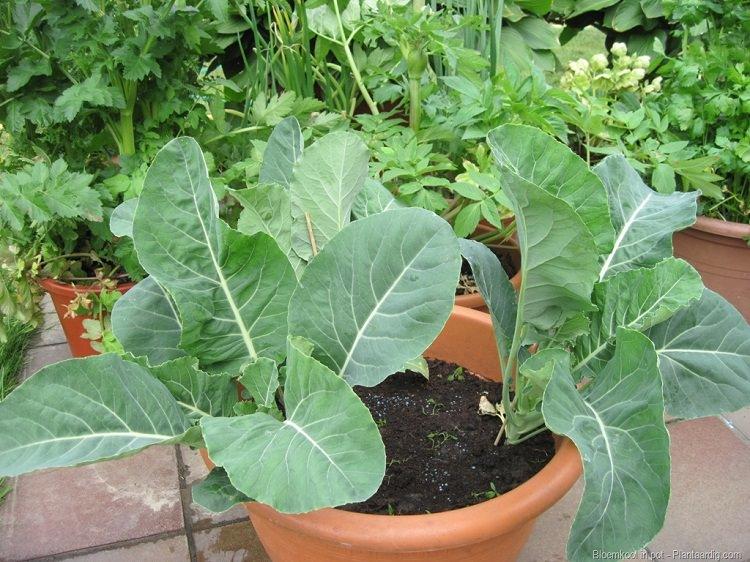
Position
Prefer to keep the pot in a sunny spot that receives at least 6 hours of sun. In tropics, grow the plant in a partial sun.
Soil
Like all brassicas, cauliflowers are quite demanding on the soil. Fill the pot with a quality potting soil that is light, deep, humus-rich and slightly clayey. As cauliflower grows best in moist soil choose the substrate that holds some moisture but also drains well.
Watering
Because growing cauliflower requires moist soil, you’ll need to water it regularly. It is important to prevent the drying of the soil in the period when the seedling is maturing and at the time of head formation. Drought-like conditions lead to the formation of smaller or separate heads or even to a complete loss of them. Overwatering also impede its growth, which must be avoided.
Cauliflower Plant Care
When the head or flower (curd) of cauliflower becomes 2-3 inches in diameter (this is unnecessary for colored varieties), cover it with the inner leaves by breaking or tying them over the head. It is called blanching. This will protect the head from the sun and you’ll get healthy white colored and more flavorsome cauliflower after harvest.
Fertilizer
Cauliflower plant is a heavy feeder. You can mix compost or well-rotted manure into the soil at the time of planting. Besides this, fertilize it with 10-10-10 water soluble fertilizer monthly.
Mulching
Mulching can be skipped when you’re growing cauliflower in containers. But you can do it to keep the soil cool and preserve moisture in the soil. In winter, mulching will keep the soil warm and insulate the roots from cold.
Pests and Diseases
Pests that damage the leaves, such as flea beetles, the larva of cabbage butterfly and moths love to feed on this plant. It can also be attacked by aphids and white flies.
In diseases, it is infected by clubroot, which can be checked if quality soil is used. It also gets affected by powdery mildew. To prevent it, avoid wetting the foliage.
Harvesting
The harvesting of cauliflower takes place virtually throughout the year, depending on the variety and sowing period. Generally, harvesting takes place about 3-4 months after planting.
You can check if cauliflower is ready for harvest when the head (curd) is fully developed (6 to 12 inches in diameter, depending on the variety) and still compact. Once the blanching is done you can harvest the cauliflower in 7-12 days.
Things to RememberCauliflower heads (flowers) become ready for harvest in 3-5 months.Cauliflower requires moderate temperature, around 60 – 75 F is ideal.Too high or too cold temperature leads to premature heading.Cauliflower requires constant nutrient supply and slightly moist soil with ideal pH around 6.5-6.8.Right watering is the key to growing cauliflowers. For the best result, water carefully. Both underwatering or overwatering must be avoided.

However, cauliflower is a cool season crop but there are many hybrid cultivars available for both temperate and tropical weather, which means it can be grown diversely in a variety of climates.
How to Grow Cauliflower in ContainersPlanting cauliflower in containers
It is important to plant the variety that fits the season and climate you are living in. Cauliflowers can be planted anytime in frost free climate when the temperature is in the range of 50-85 F (10 C to 30 C). At the time when heads are maturing, the ideal temperature is around 60-70 F (15-20 C).
Generally, in warmer regions (USDA Zone 9 – 11), you can start to sow cauliflower seeds in fall and continue to sow the seeds until the end of winter. In cooler zones, it is better to sow the seeds until late winter and up to spring to get summer or fall harvest.
Propagation
Sowing, transplanting, and planting is same as for the cabbages. Sow the seeds in a seed starting mix, 1 or 2 cm deep and 4 cm apart. Once the seedlings germinated and plants have 3 or 4 leaves, you can start growing cauliflower in containers.
Choosing a Container
Choose a pot that is 12 inches deep and at least 10 inches wide to allow enough room for a plant to grow. Also, make sure it has enough drainage holes in the bottom. In such a pot you can grow one plant.
You can also grow 2-3 cauliflower plants together in large buckets, half whiskey barrels and even in sacks.
Requirements for Growing Cauliflower in Containers

Position
Prefer to keep the pot in a sunny spot that receives at least 6 hours of sun. In tropics, grow the plant in a partial sun.
Soil
Like all brassicas, cauliflowers are quite demanding on the soil. Fill the pot with a quality potting soil that is light, deep, humus-rich and slightly clayey. As cauliflower grows best in moist soil choose the substrate that holds some moisture but also drains well.
Watering
Because growing cauliflower requires moist soil, you’ll need to water it regularly. It is important to prevent the drying of the soil in the period when the seedling is maturing and at the time of head formation. Drought-like conditions lead to the formation of smaller or separate heads or even to a complete loss of them. Overwatering also impede its growth, which must be avoided.
Cauliflower Plant Care
When the head or flower (curd) of cauliflower becomes 2-3 inches in diameter (this is unnecessary for colored varieties), cover it with the inner leaves by breaking or tying them over the head. It is called blanching. This will protect the head from the sun and you’ll get healthy white colored and more flavorsome cauliflower after harvest.
Fertilizer
Cauliflower plant is a heavy feeder. You can mix compost or well-rotted manure into the soil at the time of planting. Besides this, fertilize it with 10-10-10 water soluble fertilizer monthly.
Mulching
Mulching can be skipped when you’re growing cauliflower in containers. But you can do it to keep the soil cool and preserve moisture in the soil. In winter, mulching will keep the soil warm and insulate the roots from cold.
Pests and Diseases
Pests that damage the leaves, such as flea beetles, the larva of cabbage butterfly and moths love to feed on this plant. It can also be attacked by aphids and white flies.
In diseases, it is infected by clubroot, which can be checked if quality soil is used. It also gets affected by powdery mildew. To prevent it, avoid wetting the foliage.
Harvesting
The harvesting of cauliflower takes place virtually throughout the year, depending on the variety and sowing period. Generally, harvesting takes place about 3-4 months after planting.
You can check if cauliflower is ready for harvest when the head (curd) is fully developed (6 to 12 inches in diameter, depending on the variety) and still compact. Once the blanching is done you can harvest the cauliflower in 7-12 days.
Things to RememberCauliflower heads (flowers) become ready for harvest in 3-5 months.Cauliflower requires moderate temperature, around 60 – 75 F is ideal.Too high or too cold temperature leads to premature heading.Cauliflower requires constant nutrient supply and slightly moist soil with ideal pH around 6.5-6.8.Right watering is the key to growing cauliflowers. For the best result, water carefully. Both underwatering or overwatering must be avoided.
1
0
文章
Andrea
2017年05月22日


I used to grow vegetables in a larger separate garden here at TGG, but have since moved into a home with less space and open ground. I find that I do miss fresh herbs and veggies on my table, and so I have come up with some simple ways anyone can use to grow fresh vegetables even if their space is small, their soil is poor, or their motivation for lots of hard work is low! Did I mention? Growing your own vegetables is more nutritious for your family, and fattens up the checkbook too. Now is the perfect time of year to get started.
Grow Vegetables in Containers
You may be thinking, who has containers that big? Seriously, in today’s gardening world, you can find almost any veggie in a smaller container friendly version. Even summer squash and bush beans can easily be grown in as little as 12 inch pots.
Make sure you fertilize with every water with half strength liquid fertilizer, and make sure they don’t dry out in the container.
Don’t want your patio to look like a community container garden? No problem! Just add a couple decorative plants along the edge of each container, and let the vege be the foliage and texture.
Tuck Them Into Bed
Garden beds, that is! Again, compact varieties can be tucked right into those empty spots in the garden where the petunias were last year. Many types of herbs and vegetables can be quite ornamental as well. Try purple basil, Swiss chard, artichokes, red peppers, leaf lettuces and purple bush beans. Till up the spot in the garden bed you wish to plant with a spade, plant some seeds, cover with a little soil, water and fertilize. Many times your automatic watering system will make the job even easier. Make sure you keep your eye out for mildew disease and spray accordingly- vegetables planted in close quarters are more susceptible. You might find them so pretty you want to keep planting them every year, just for good looks!
Community Gardens
In many communities there are gardens set up exclusively for growing your own food, when you cannot grow at home. Some of these gardens are free, others charge a small fee. Depending on the size plot you are allotted, consider growing an extra row of food for food banks. It doesn’t take any longer to care for one more row of food, but can make a big difference in your community to a family who is struggling. One packet of seed costs $1.50. So check out community gardens, and make it a family project to care for your vegetables each evening! Find out more about community gardens at http://communitygarden.org/
Growing vegetables can be simple, and can include a separate vegetable garden to feed your whole family, or just one pot of lovingly tended tomatoes on the back porch. It’s can be as simple as you want to make it, but there is nothing like fresh vegetables and herbs on a summer table, so give at least one a try this season.
Are you growing vegetables this season? Comment and let us know what your garden includes!
0
0
文章
Andy
2017年05月22日

Learn how to grow dill in tropics. In warm, tropical climate you require a different approach to grow this herb. Growing dill in containers is also possible, which is given in this educative guide.
Dill is an aromatic annual herb grown for its use in various cuisines. It is a wild plant that attracts butterflies and bees and other beneficial insects.
Difficulty — Easy
Soil pH — slightly acidic to neutral
Scientific Name-– Anethum graveolens
Growing Habit
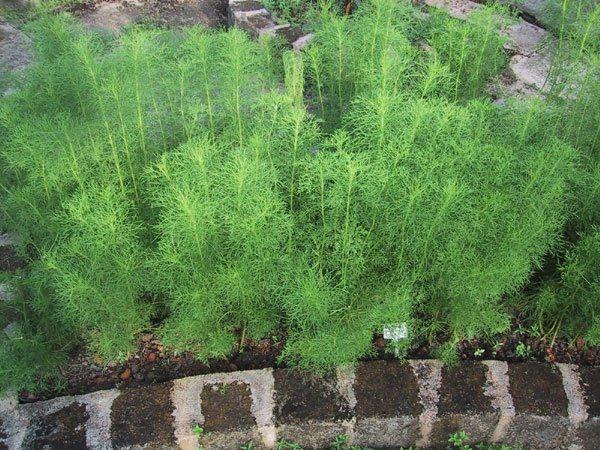
Dill is an upright plant that can grow up to 75 cm tall, it has slightly bluish and green colored scented finely cut leaves and mustard colored umbel flowers. Dill grows well in garden beds and vegetable patches. Growing dill in pots and indoors is also possible.
You can grow dill at anytime when the temperature is around 50 – 80 F (10 – 27 C). In cooler climates, it is grown in spring, summer and up to fall in warm temperate zones. But if you live in tropics, grow dill in fall and winter.
Planting dill
Sow seeds 1/4 inches deep on a bright spot that receive morning sun. One thing you should note that dill hates to be transplanted later, so make sure you’ll sow seeds at exact place or in container where you would like to plant them later. Seeds will germinate in between 7 – 21 days. When seedlings are 2 – 3 inches high, thin them to 10 inches apart.
Growing dill in Containers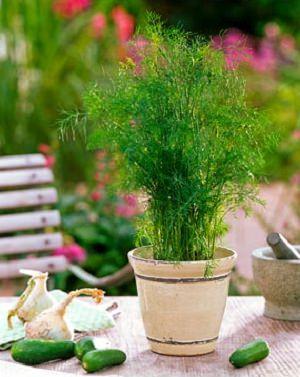
Dill can grow up to 3 feet high, unlike other herbs it has long tap root so it requires deep pot. Choose at least 12 inches deep container that has sufficient drainage. In a single container you can grow 2 -3 plants together.
Location
Dill, in order to grow healthy and lush, needs a Mediterranean climate. It prefers full sun. You also need to protect the plant from extreme tropical conditions, only then can you grow it successfully. Whether in pots on the balcony, patio or terrace or in the garden, ensure the plant remains on a less windy position, that is sunny. Keep the plant in afternoon shade if temperature rises up.
Watering
Dill tolerates drought and its flavor increases if it is allowed to be slightly “thirsty”. But in tropics you’ll need to keep the soil relatively moist. Avoid overwatering in any case.
Also Read: How to Make Balcony Herb Garden
Soil
It can tolerate poor soil, but in fertile soil rich tasting dill is produced. Amend the soil by mixing plenty of aged manure or compost and sand, if needed.
Fertilizer
Generally, dill does not require frequent fertilizer but to give boost to plant you can feed 5-10-5 fertilizer lightly. If you’re growing dill in containers fertilize the plant every month with half strength liquid fertilizer.
Mulching
Cover the plant with a 2-inch layer of organic mulch once the plants are 4 inches high. Mulch gives plant stability, suppresses weeds and keeps the soil moist.
Pinching and Deadheading
Pinch the plant when it grows above 6 inches tall for bushier growth. Nip off the tips regularly. Do not allow the plant to flower and seed, if you want a longer growing period.
Harvest
Harvest the leaves when the plant is 6 inches high. Once dill brings to flower, it will stop growing leaves, so if you want to keep harvesting the leaves, pinch flower buds when they are small. If you want seeds, stop deadheading. To harvest the seeds, cut the seed heads once they have turned brown.
Dill is an aromatic annual herb grown for its use in various cuisines. It is a wild plant that attracts butterflies and bees and other beneficial insects.
Difficulty — Easy
Soil pH — slightly acidic to neutral
Scientific Name-– Anethum graveolens
Growing Habit

Dill is an upright plant that can grow up to 75 cm tall, it has slightly bluish and green colored scented finely cut leaves and mustard colored umbel flowers. Dill grows well in garden beds and vegetable patches. Growing dill in pots and indoors is also possible.
You can grow dill at anytime when the temperature is around 50 – 80 F (10 – 27 C). In cooler climates, it is grown in spring, summer and up to fall in warm temperate zones. But if you live in tropics, grow dill in fall and winter.
Planting dill
Sow seeds 1/4 inches deep on a bright spot that receive morning sun. One thing you should note that dill hates to be transplanted later, so make sure you’ll sow seeds at exact place or in container where you would like to plant them later. Seeds will germinate in between 7 – 21 days. When seedlings are 2 – 3 inches high, thin them to 10 inches apart.
Growing dill in Containers

Dill can grow up to 3 feet high, unlike other herbs it has long tap root so it requires deep pot. Choose at least 12 inches deep container that has sufficient drainage. In a single container you can grow 2 -3 plants together.
Location
Dill, in order to grow healthy and lush, needs a Mediterranean climate. It prefers full sun. You also need to protect the plant from extreme tropical conditions, only then can you grow it successfully. Whether in pots on the balcony, patio or terrace or in the garden, ensure the plant remains on a less windy position, that is sunny. Keep the plant in afternoon shade if temperature rises up.
Watering
Dill tolerates drought and its flavor increases if it is allowed to be slightly “thirsty”. But in tropics you’ll need to keep the soil relatively moist. Avoid overwatering in any case.
Also Read: How to Make Balcony Herb Garden
Soil
It can tolerate poor soil, but in fertile soil rich tasting dill is produced. Amend the soil by mixing plenty of aged manure or compost and sand, if needed.
Fertilizer
Generally, dill does not require frequent fertilizer but to give boost to plant you can feed 5-10-5 fertilizer lightly. If you’re growing dill in containers fertilize the plant every month with half strength liquid fertilizer.
Mulching
Cover the plant with a 2-inch layer of organic mulch once the plants are 4 inches high. Mulch gives plant stability, suppresses weeds and keeps the soil moist.
Pinching and Deadheading
Pinch the plant when it grows above 6 inches tall for bushier growth. Nip off the tips regularly. Do not allow the plant to flower and seed, if you want a longer growing period.
Harvest
Harvest the leaves when the plant is 6 inches high. Once dill brings to flower, it will stop growing leaves, so if you want to keep harvesting the leaves, pinch flower buds when they are small. If you want seeds, stop deadheading. To harvest the seeds, cut the seed heads once they have turned brown.
0
0
文章
Hande Salcan
2017年05月22日

Learn how to grow prickly pear cactus in this article. Growing prickly pear cactus and its care is not difficult, if you grow it in right growing conditions.
USDA Zones— 9 – 11
Difficulty— Easy

Other Names— Barbary-fig Cactus, Cactus Pear Fruit, Gracemere-Pear, Indian-fig, Indian fig, Nopal Cactus, Oponce, Opuntia, Opuntia cardona, Opuntia ficus, Opuntia ficus-indica, Opuntia fuliginosa, Opuntia hyptiacantha, Opuntia lasciacantha, Opuntia macrocentra, Opuntia megacantha, Opuntia puberula, Opuntia streptacantha, Opuntia velutina, Opuntia violacea, Tuna Cardona, Westwood-Pear.
Also known as Indian fig, prickly pear is a common succulent plant in Mediterranean and subtropical regions. It is grown as an ornamental plant and for its juicy fruits. Prickly pear cactus is undemanding and easy to grow. It grows about 1 – 2.5 m high. The flowers are very showy, colors ranging from white, yellow, to orange, depending more on the variety.How to Grow Prickly Pear CactusPropagation
Prickly pear cactus can be propagated from seeds or pads. Growing prickly pear from the pad is comparatively easy than seeds. To facilitate the rooting, it is preferable to wait until the cuts are perfectly healed (about 1 – 2 week) before planting. Tuck them an inch deep on the ground or in containers. The rooting takes place in a short time, usually in a month. Save the rooting pad from afternoon sun and water it when top one inch of soil seems dry.
Location
Growing prickly pear cactus in a sunny location allows the plant to thrive and fruit. Prickly pear cactus is a tropical or subtropical plant, so it loves the warm exposure. However, it can withstand temperatures down to 14 F (-10 C), but in areas, with harsh winters it is best to plant it in a sheltered spot, near a wall or tall tree to protect it from cold drafts and fluctuation in temperature. If you’re living in a cooler climate, growing prickly pear cactus in a container is the better option for you as it can only be grown on the ground where winter temperature remains above 14 F (- 10 C).
Requirements for Growing Prickly Pear CactusSoil
Grow it in well-drained, sandy and loamy soil, avoid clay-rich soil that is not well draining and remains moist. For growing prickly pear cactus in a container use potting mix or 1/3 part each of compost, soil, and coarse sand or perlite.
Watering
Watering should be done only when the surface looks dry. On average, during the spring and summer, water it once or twice a week and during the fall and winter once or twice a month. If you’re living in tropics more frequent watering will be required.
Repotting
If growing in a pot, the plant must be repotted once it is root bound. Whenever you identify that the plant is growing slowly, repot it. The best repotting time is spring.
Prickly Pear Cactus Care
Prickly pear cactus care involves several steps that are given below.
Fertilizer
From spring to fall, fertilize every month with a liquid 5-10-10 fertilizer to promote flowering and fruiting. For the young plant, fertilize with 10-10-10 fertilizer. Do not feed in winter in cooler zones when plant stops to grow.
Pruning
Pruning is done in spring or late summer by removing the pads that come into contact with each other or those that are damaged or poorly formed.
Overwintering
Prickly pear cactus care in winter is essential. If you’re growing prickly pear cactus in a pot, protect it in winter by keeping it indoors. If growing outside, do mulching to insulate the plant from temperature drop.
Fruit thinning
Fruit thinning is done to get a better harvest. It is necessary to remove extra fruits and flowers to get lower production but of improved quality. It is recommended that thinning must be done two weeks before the formation of the fruits, leaving approximately up to 10 fruits per stalk.
Pests and Diseases
Mealybugs, spider mites, and cochineal might attack it. It is also attacked by fruit flies and moths.
Too much water or cold causes rotting. As soon as you detect the softening of tissues, remove the rotten part and treat the infected part with fungicide.
Harvesting
USDA Zones— 9 – 11
Difficulty— Easy

Other Names— Barbary-fig Cactus, Cactus Pear Fruit, Gracemere-Pear, Indian-fig, Indian fig, Nopal Cactus, Oponce, Opuntia, Opuntia cardona, Opuntia ficus, Opuntia ficus-indica, Opuntia fuliginosa, Opuntia hyptiacantha, Opuntia lasciacantha, Opuntia macrocentra, Opuntia megacantha, Opuntia puberula, Opuntia streptacantha, Opuntia velutina, Opuntia violacea, Tuna Cardona, Westwood-Pear.
Also known as Indian fig, prickly pear is a common succulent plant in Mediterranean and subtropical regions. It is grown as an ornamental plant and for its juicy fruits. Prickly pear cactus is undemanding and easy to grow. It grows about 1 – 2.5 m high. The flowers are very showy, colors ranging from white, yellow, to orange, depending more on the variety.How to Grow Prickly Pear CactusPropagation
Prickly pear cactus can be propagated from seeds or pads. Growing prickly pear from the pad is comparatively easy than seeds. To facilitate the rooting, it is preferable to wait until the cuts are perfectly healed (about 1 – 2 week) before planting. Tuck them an inch deep on the ground or in containers. The rooting takes place in a short time, usually in a month. Save the rooting pad from afternoon sun and water it when top one inch of soil seems dry.
Location
Growing prickly pear cactus in a sunny location allows the plant to thrive and fruit. Prickly pear cactus is a tropical or subtropical plant, so it loves the warm exposure. However, it can withstand temperatures down to 14 F (-10 C), but in areas, with harsh winters it is best to plant it in a sheltered spot, near a wall or tall tree to protect it from cold drafts and fluctuation in temperature. If you’re living in a cooler climate, growing prickly pear cactus in a container is the better option for you as it can only be grown on the ground where winter temperature remains above 14 F (- 10 C).
Requirements for Growing Prickly Pear CactusSoil
Grow it in well-drained, sandy and loamy soil, avoid clay-rich soil that is not well draining and remains moist. For growing prickly pear cactus in a container use potting mix or 1/3 part each of compost, soil, and coarse sand or perlite.
Watering
Watering should be done only when the surface looks dry. On average, during the spring and summer, water it once or twice a week and during the fall and winter once or twice a month. If you’re living in tropics more frequent watering will be required.
Repotting
If growing in a pot, the plant must be repotted once it is root bound. Whenever you identify that the plant is growing slowly, repot it. The best repotting time is spring.
Prickly Pear Cactus Care
Prickly pear cactus care involves several steps that are given below.
Fertilizer
From spring to fall, fertilize every month with a liquid 5-10-10 fertilizer to promote flowering and fruiting. For the young plant, fertilize with 10-10-10 fertilizer. Do not feed in winter in cooler zones when plant stops to grow.
Pruning
Pruning is done in spring or late summer by removing the pads that come into contact with each other or those that are damaged or poorly formed.
Overwintering
Prickly pear cactus care in winter is essential. If you’re growing prickly pear cactus in a pot, protect it in winter by keeping it indoors. If growing outside, do mulching to insulate the plant from temperature drop.
Fruit thinning
Fruit thinning is done to get a better harvest. It is necessary to remove extra fruits and flowers to get lower production but of improved quality. It is recommended that thinning must be done two weeks before the formation of the fruits, leaving approximately up to 10 fruits per stalk.
Pests and Diseases
Mealybugs, spider mites, and cochineal might attack it. It is also attacked by fruit flies and moths.
Too much water or cold causes rotting. As soon as you detect the softening of tissues, remove the rotten part and treat the infected part with fungicide.
Harvesting
0
0
文章
Hande Salcan
2017年05月22日

Juiciest and largest fruit from citrus family learn how to grow pomelo. Growing pomelo is not so difficult if you follow the directions given below.

Family– Rutaceae
Genus– Citrus
Other names– Citrus maxima, shaddock, pomelo, pummelo, pommelo, pamplemousse, or shaddok) jeruk besar, jeruk bali, jambua, limau betawi, limau bali, muli, som-o, ma-o, shouk-ton-oh, suha, lukban, kabugaw and buongon.
USDA Zones — 9 to 11
Propagation — Seed, Rootstock
Difficulty — Easy
Bloom Color — White
Height — 15 feet to 40 feet
About Pomelo
Pomelo or Pummelo is largest fruit of citrus family having up to 10 inches fruits, which are sweet and tart in taste with easily removable orange like thick pale yellow skin.
Growing condition for Pomelo
As pomelo is a subtropical evergreen tree, it grows best in warm and humid climate. It does not like cold. If you’re growing pomelo in cold weather grow it in a pot.
RequirementsSun
Like all citrus varieties, pomelo needs full sun to produce its large juicy fruits. It can also be grown in partial sun, but it will produce less fruits.
Soil
Pomelo can be grown in many types of soil, however in grows best in medium textured soil of pH around 5.5 to 7. *Soil must be well draining to prevent root rot.
Watering
Pomelo likes moist soil. If grown on ground it should be watered at least once a week. Watering should be consistent and deep. Over-watering, under-watering or inconsistent watering can lead to blossom drop and fruit drop.
CareFertilizer
Feed with citrus fertilizer according to the product instruction given on the packet.
Harvest
Like most citrus fruits, pomelo may appear fully ripe weeks before it is actually ripe. The best method to check if the fruit is ripe is to taste it.
Pests and diseases

Family– Rutaceae
Genus– Citrus
Other names– Citrus maxima, shaddock, pomelo, pummelo, pommelo, pamplemousse, or shaddok) jeruk besar, jeruk bali, jambua, limau betawi, limau bali, muli, som-o, ma-o, shouk-ton-oh, suha, lukban, kabugaw and buongon.
USDA Zones — 9 to 11
Propagation — Seed, Rootstock
Difficulty — Easy
Bloom Color — White
Height — 15 feet to 40 feet
About Pomelo
Pomelo or Pummelo is largest fruit of citrus family having up to 10 inches fruits, which are sweet and tart in taste with easily removable orange like thick pale yellow skin.
Growing condition for Pomelo
As pomelo is a subtropical evergreen tree, it grows best in warm and humid climate. It does not like cold. If you’re growing pomelo in cold weather grow it in a pot.
RequirementsSun
Like all citrus varieties, pomelo needs full sun to produce its large juicy fruits. It can also be grown in partial sun, but it will produce less fruits.
Soil
Pomelo can be grown in many types of soil, however in grows best in medium textured soil of pH around 5.5 to 7. *Soil must be well draining to prevent root rot.
Watering
Pomelo likes moist soil. If grown on ground it should be watered at least once a week. Watering should be consistent and deep. Over-watering, under-watering or inconsistent watering can lead to blossom drop and fruit drop.
CareFertilizer
Feed with citrus fertilizer according to the product instruction given on the packet.
Harvest
Like most citrus fruits, pomelo may appear fully ripe weeks before it is actually ripe. The best method to check if the fruit is ripe is to taste it.
Pests and diseases
0
0
文章
Hande Salcan
2017年05月22日

Learn how to grow calamansi in this guide. Growing calamansi is rewarding. Its exotic citrus like fragrance and mix of tangy, sweet flavor of lime and tangerine of its fruit makes it a worth fruit tree.

USDA Hardiness Zones — 9 – 11, *can be grown in containers in cooler zones
Difficulty — Moderate
Other Names — calamonding, calamondin orange, calamansi, calamandarin, golden lime, kalamunding, kalamansi, Philippine lime, Panama orange, Chinese orange, musk orange and acid orange.
Family — Rutaceae
Genus — Citrofortunella
Temperature— 60 – 90 F is optimum growing temperature
Propagation Method — Seeds, cuttings
About Calamansi
Calamansi is a tropical fruit of citrus variety, sized between orange and lime. This small fruit tree grows mostly in South East Asia. It is mostly grown for ornamental purposes in other parts of the world. Calamansi bears smaller fruits than orange which are sour, a little bit sweeter and juicy in taste.
Growing Condition
Calamansi tree grows in warm tropical and subtropical climate. The growing conditions are similar to that of other citrus trees.
Requirements for Growing CalamansiSun
Growing calamansi in full sun is required for healthy growth. Proper exposure to sun and temperature improves productivity.
Soil
Calamansi grows well in dry soil that doesn’t retain moisture and remains waterlogged.
Watering
Water deeply but only when the top layer of soil dries out, calamansi plant doesn’t like wet feet.
How to Plant Calamansi
If your climate is frost free and remains warm throughout the year, plant it outside. If you live below USDA Zone 9b, it is better to plant it in a container.
Calamnsi CareFertilizer
Fertilize your calamansi plant every other month during the growing period with liquid fertilizer that is rich in nitrogen and potassium.
Harvest
It starts to bear fruits after two-three years of growing calamansi plant and produce them throughout the year intermittently (*in tropics). You can either harvest them young when the color of peel looks variegated pale green or wait until they fully ripen and resemble orange like color.
Pests and Diseases

USDA Hardiness Zones — 9 – 11, *can be grown in containers in cooler zones
Difficulty — Moderate
Other Names — calamonding, calamondin orange, calamansi, calamandarin, golden lime, kalamunding, kalamansi, Philippine lime, Panama orange, Chinese orange, musk orange and acid orange.
Family — Rutaceae
Genus — Citrofortunella
Temperature— 60 – 90 F is optimum growing temperature
Propagation Method — Seeds, cuttings
About Calamansi
Calamansi is a tropical fruit of citrus variety, sized between orange and lime. This small fruit tree grows mostly in South East Asia. It is mostly grown for ornamental purposes in other parts of the world. Calamansi bears smaller fruits than orange which are sour, a little bit sweeter and juicy in taste.
Growing Condition
Calamansi tree grows in warm tropical and subtropical climate. The growing conditions are similar to that of other citrus trees.
Requirements for Growing CalamansiSun
Growing calamansi in full sun is required for healthy growth. Proper exposure to sun and temperature improves productivity.
Soil
Calamansi grows well in dry soil that doesn’t retain moisture and remains waterlogged.
Watering
Water deeply but only when the top layer of soil dries out, calamansi plant doesn’t like wet feet.
How to Plant Calamansi
If your climate is frost free and remains warm throughout the year, plant it outside. If you live below USDA Zone 9b, it is better to plant it in a container.
Calamnsi CareFertilizer
Fertilize your calamansi plant every other month during the growing period with liquid fertilizer that is rich in nitrogen and potassium.
Harvest
It starts to bear fruits after two-three years of growing calamansi plant and produce them throughout the year intermittently (*in tropics). You can either harvest them young when the color of peel looks variegated pale green or wait until they fully ripen and resemble orange like color.
Pests and Diseases
1
0




